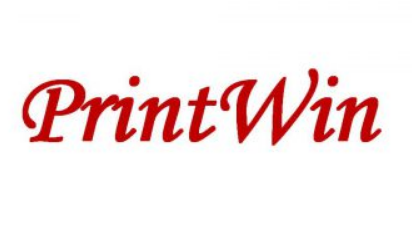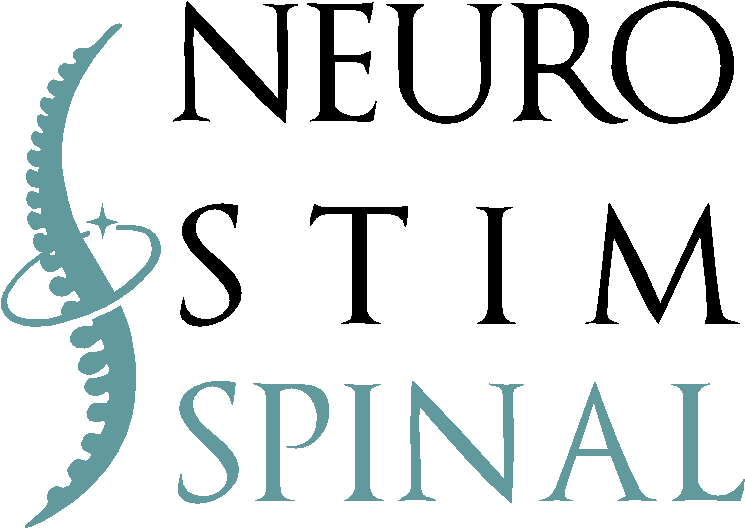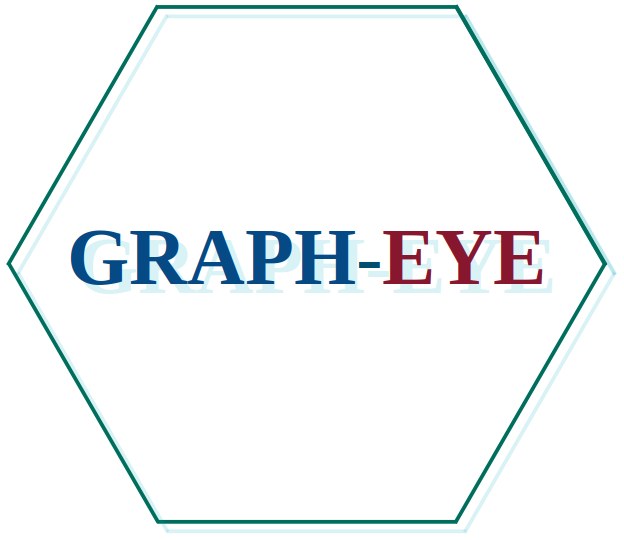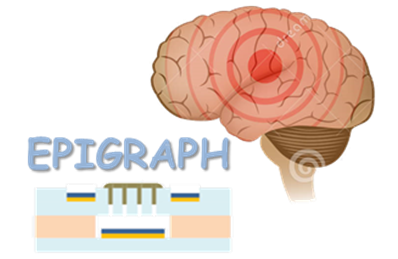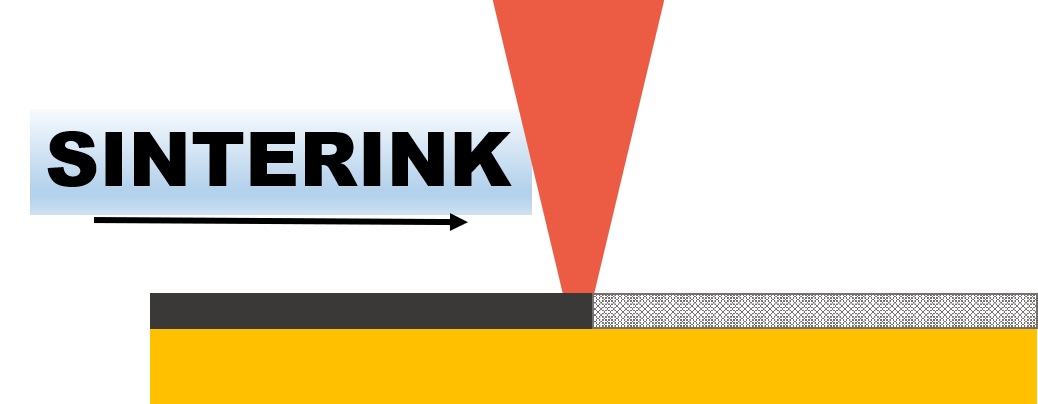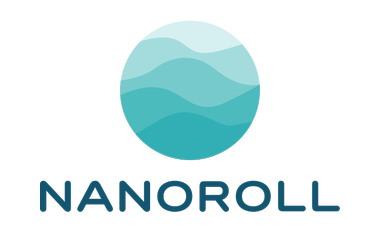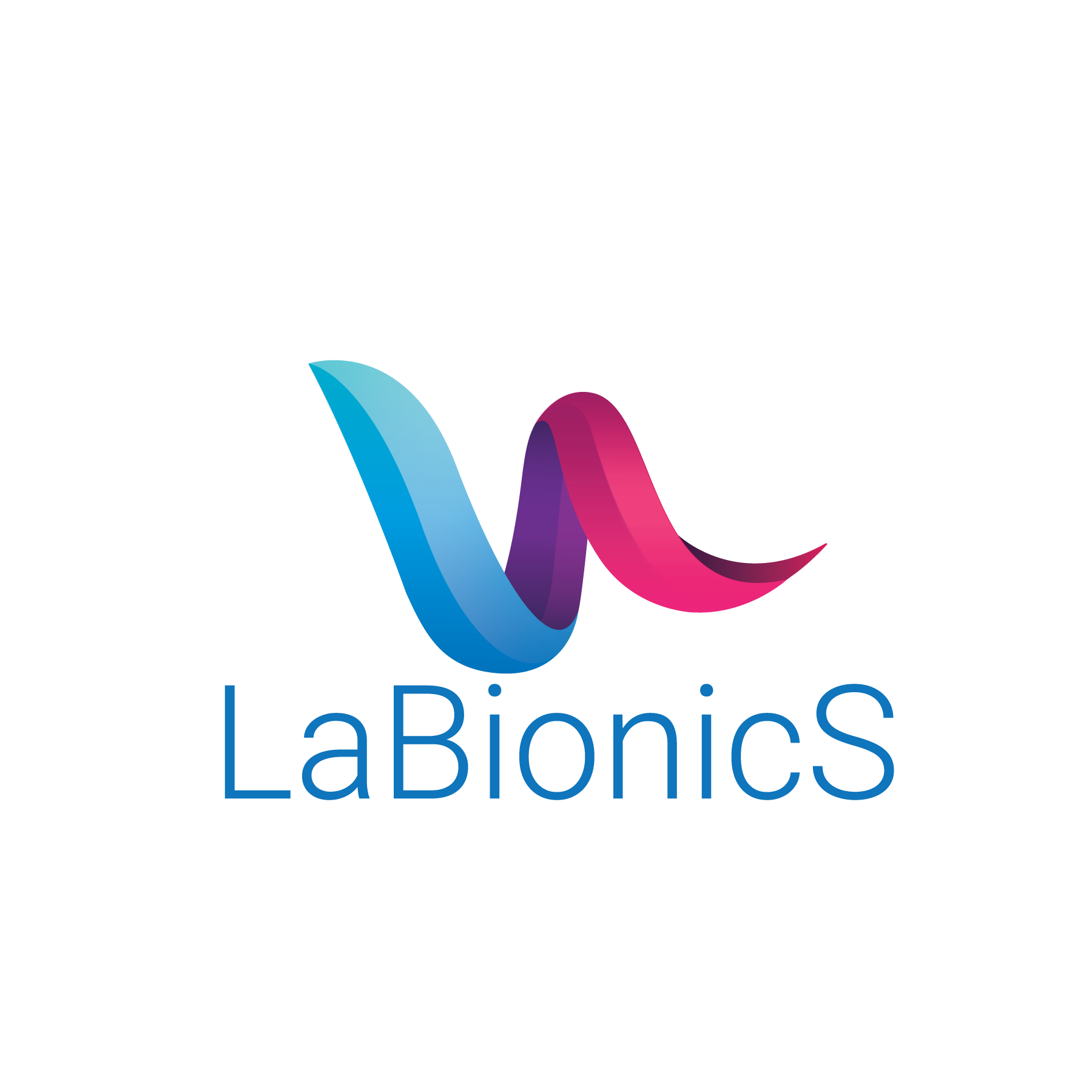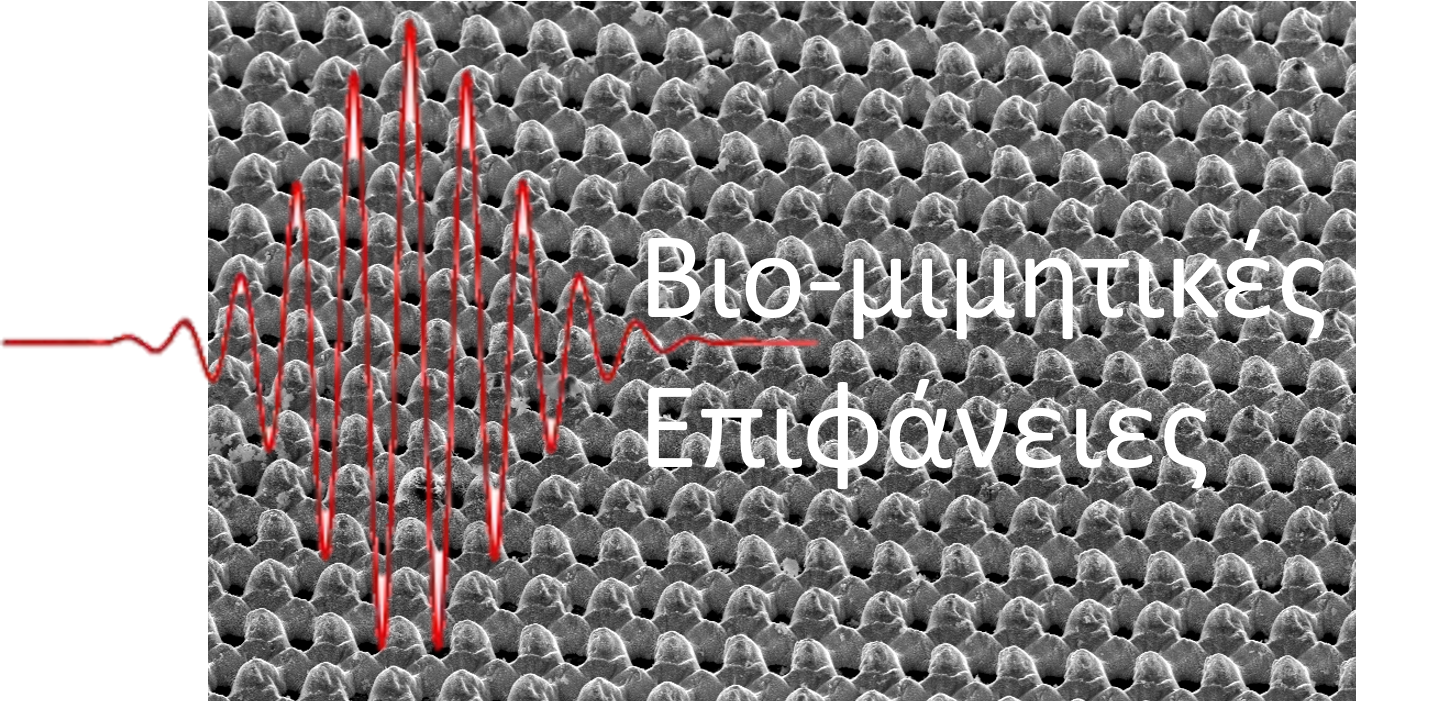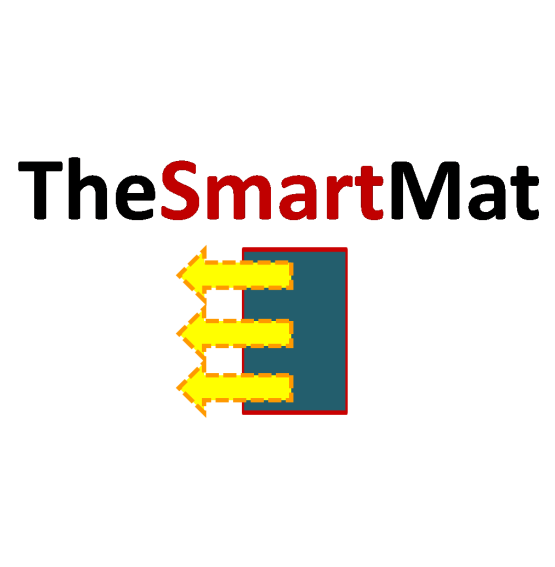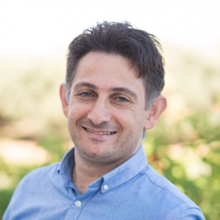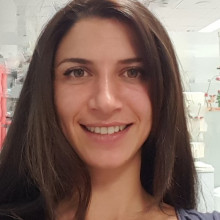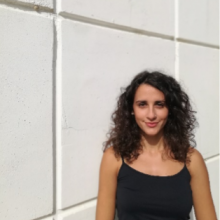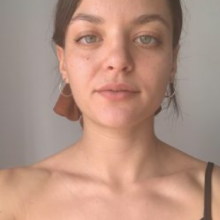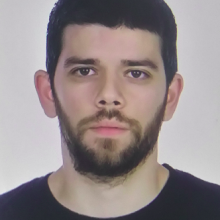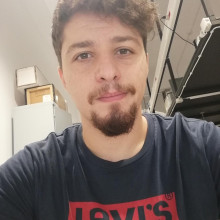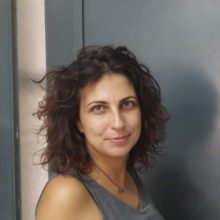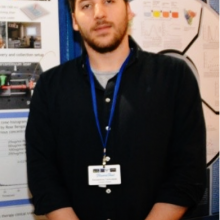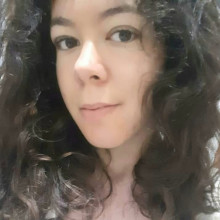In the Ultrafast Laser Micro- and Nano- processing group (ULMNP) of IESL research is focused on the development of novel ultrafast pulsed laser processing schemes for controlled biomimetic structuring at micro- and nano- scales of a variety of materials, including biopolymers. By applying ultrafast laser pulses novel surface structures with sub-micron sized features are produced while the physical properties of semiconductor, dielectric and metallic surfaces are significantly modified. The biomimetic surfaces developed exhibit controlled dual-scale morphology, that mimics the hierarchical structuring of natural surfaces with exciting properties (i.e. the Lotus leaf, the Shark Skin, the Butterfly wings). As a result, the biomimetic morphology attained gives rise to notable multifunctional properties including water repellence, self-cleaning, antibacterial, anti-sticking, anti-fogging, anti-reflection and combination of those (b) smart, i.e show the ability to change their functionality in response to different external stimuli. The ability to tailor the morphology and chemistry is an important advantage for the use of the biomimetic structures as models to study the dependence of growth, division and differentiation of cells on the surface energy of the culture substrat, as well as 3D scaffolds for tissue regeneration. At the same time, novel ultrafast non-linear imaging tools are employed to characterise the biological processes taking place during the development of tissue into 3D scaffolds. At the same time, ULMNP focuses on the ultrafast laser-based development of various types of nanomaterials, nanolayers and processes applied in photovoltaic, gas sensing and energy storage applications. The exploitation of ultrashort pulses for the doping, functionalization, spectroscopic diagnosis and quality control of graphene and other 2D materials is additionally explored, placing emphasis on the understanding of the fundamental physical properties of such materials.
Research Topics
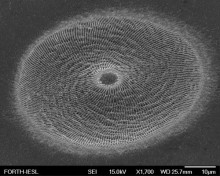
Ultrafast Laser Processing of Materials
Activities-challenges: Bio-inspired surface modification and functionalization of solid surfaces via ultrashort laser pulses in various types of materials (i.e. semiconductors, metals, dielectrics, polymers), investigation of surface micro/nano structure role on wetting, optical, and tribological applications. Control of surface morphology with shaped ultrashort double pulses. Development of laser induced metasurfaces and investigation of the physical mechanisms that lead to laser induced surface structure formation.
Biomimetic laser processing
Wetting properties: By applying ultrashort UV, VIS and IR laser pulses novel surface structures with sub-micron sized features are produced while the physical properties of semiconductor, dielectric and metallic surfaces are significantly modified. Developed methods include laser micro/nano surface structuring performed in different media, direct laser writing with variable laser polarization states and combination of those. Further control over the surface topology is achieved by proper functionalization of the 3D structures obtained with well-defined nanostructures. The artificial surfaces developed by processing under ambient controlled gaseous environments or in ambient environment exhibit controlled dual-scale roughness, that mimics the complexity of hierarchical morphology of natural surfaces with exciting wetting properties (i.e. the Lotus leaf, Texas horned Lizard), comprising micro-conical structures decorated with nanometer sized protrusions. The biomimetic morphology attained gives rise to notable wetting properties when combined with methods of tailoring the surface chemistry.
Figure 1: Wetting response and SEM pictures of actual lotus leaf (left) and fs treated silicon (right) surfaces
Optical properties Based on the concepts and underlying principles discovered in nature, an interdisciplinary field has been developed, aiming to design and fabricate photonic biomimetic structures. This capability comes as the outcome of the optimal combination of the ultrafast laser field and material properties that enable the production of features with sizes beyond the diffraction limit (i.e., nanoscale) that can mimic the functionalities of cicada and butterfly wings. A prominent example is the formation of self‐organized subwavelength, laser‐induced periodic surface structures (LIPSS), which have been proven an important asset for the fabrication of nanostructures with a plethora of geometrical features. With precise ultrafast laser processing we can produced high anti-reflective artificial glass surfaces and high absorbing metal and semiconductor materials [1].
Figure 2: SEM images of actual cicada Cretensis wing (left) and of an fs treated glass surface (right). Photograph of half treated glass SiO2 with reduced light reflection (below).
Tribological properties: A prominent aspect of the fs laser material interaction is that the spatial features of the surface structures attained are strongly correlated with the laser beam polarization. However, to date, laser fabrication of biomimetic structures has been demonstrated using laser beams with a Gaussian intensity spatial profile and spatially homogeneous linear polarization. In this context and based on the sensitivity of laser induced structures on laser polarization, it is possible to further advance the complexity of the fabricated structures via utilizing laser beams with a spatially inhomogeneous state of polarization. Therefore we can mimic the skin of elasmobranches like shark for in water drag reduction and reduced friction sliding friction under the presence of oil lubricance [2,3].
Figure 3: SEM images of actual shark skin (left) and of an fs treated metal surface (right)
Controlling 2D LIPSS formation with double pulses
Figure 4: SEM images of 2D structures induced by double pulses on stainless steel surface.
Employing DPI enables us to intervene into the evolution of the structure formation in a non-deterministic way. The interpulse delay (Δτ) is considered the main parameter in DPI, since it defines the stage of structure formation process, which is targeted by the second pulse. Depending on the Δτ value several effects have been observed on 2D LIPSS formation on stainless steel (4). When 1 ps < Δτ < 10 ps the hierarchical morphology of triangular 2D-LIPSS was tailored via tuning the high spatial frequency LIPSS (HSFL) formation (Figure 4, left). At Δτ = 20 ps 2D-HSFL were obtained and a structure morphology inversion was observed (Figure 4, center). When Δτ ranges in the nanosecond timeframe the microfluidic motion of the melt reaches its maximum amplitude. Then the second pulse intervenes to the existing temperature profile and impacts Marangoni flow. We showed that at Δτ = 0.5 ns a variety of 2D subwavelength structures were obtained (Figure 4, right), assuming the development of convection flow (CF) on the surface. According to CF theory the pattern formation apart from the amplitude and temporal profile of the excitation depends on the excitation profile, i.e. the spot profile in the case of laser irradiation (Process I). Therefore, by means of DPI we can manipulate the CF dynamics, while upon tuning of the spot profile we could define the CF pattern that will be developed.
Investigation of LIPSS formation on pre-patterned surfaces
To illustrate the role of pre-patterrned surfaces and impact of laser polarisation in the periodic pattern formation,
Figure 5a: Laser-induced ripples on a pre-patterned surface. A comparison of non-irradiated pre-pattern structures and laser-induced ripples (upper and lower SEM micrographs respectively).
Figure 5b: Electromagnetic modes that are excited which are used to explain the LIPSS formation on prepatterned surfaces.
Nickel surfaces are irradiated with femtosecond laser pulses of polarisation perpendicular or parallel to the orientation of the pre-pattern ridges. The LIPSS formation on pre-patterned surfaces aims to reveal more information regarding to the physical information of the ripples formation induced by ultrashort laser pulses. The detailed analysis of the LIPSS formation in different conditions and ridge distances can set the basis for control of the parameters to fabricate patterns with desired properties for a wide range of optoelectronic applications. To understand the LIPSS formation on prepatterned surfaces a theoretical model has been developed that discusses how the induced electromagnetic modes can account for the orientation and periodicity of the periodic structures [6].
Ultrafast laser induced metasurfaces
Metasurfaces are two-dimensional metamaterials with planar and ultrathin nanostructures that have shown exceptional abilities in light manipulation and versatility in optical applications. The core research strategy here is to exploit ultrafast laser fabrication technology combined with the state-of-the art planar metamaterial designs in order to engineer the geometric parameters of artificially constructed subwavelength meta-atoms and, thus generate a variety of metasurfaces that will enable the manipulation of optical waves in a prescribed manner.
Figure 6: Planar and ultrathin nanostructures fabricated by ultrafast laser processing of silicon
Complex structure generation with advanced spatiotemporal femtosecond beam shaping
Α novel approach for tailoring the laser induced surface topography upon femtosecond (fs) pulsed laser irradiation is followed. The method employs spatially controlled double fs laser pulses to actively regulate the hydrodynamic microfluidic motion of the melted layer that gives rise to the structures formation. The pulse train used, in particular, consists of a previously unexplored spatiotemporal intensity combination including one pulse with Gaussian and another with periodically modulated intensity distribution created by Direct Laser Interference Patterning (DLIP). The interpulse delay is appropriately chosen to reveal the contribution of the microfluidic melt flow, while it is found that the sequence of the Gaussian and DLIP pulses remarkably influences the surface profile attained (Figure 7).
Figure 7: A Gaussian and a DLIP pulse are combined in DLIP irradiation. The delay between the double pulses is 500 ps. After repetitive irradiation a variety of complex morphologies were obtained.
Figure 8: A complex morphology comprising structures in multiple length scales
Apart from the order of the pulses and the shape of the DLIP pulse, tailoring of secondary process parameters impact the induce morphology. After studying the effects of the fluence and the number of irradiations, distinct complex morphologies were obtained comprising features in multiple length scales. An example of such a surface is presented in Figure 8 and analyzed in components of different size by means of inversed furrier transformation [4,5].
Fabrication of Biomimetic 2D Nanostructures through Irradiation of Stainless Steel Surfaces with Double Femtosecond Pulses
Femtosecond laser induced changes on the topography of stainless steel with double pulses is investigated to reveal the role of parameters such as the fluence, the energy dose and the interpulse delay on the features of the produced patterns. Our results indicate that short pulse separation (Δτ = 5 ps) favors the formation of 2D Low Spatially Frequency Laser Induced Periodic Surface Structures (LSFL) while longer interpulse delays (Δτ = 20 ps) lead to 2D High Spatially Frequency LIPSS (HSFL). The detailed investigation is complemented with an analysis of the produced surface patterns and characterization of their wetting and cell-adhesion properties. A correlation between the surface roughness and the contact angle is presented which confirms that topographies of variable roughness and complexity exhibit different wetting properties. Furthermore, our analysis indicates that patterns with different spatial characteristics demonstrate variable cell adhesion response which suggests that the methodology can be used as a strategy towards the fabrication of tailored surfaces for the development of functional implants (Figure 9) [7].
Figure 9: Impact of topography produced with double pulses on stainless steel on (a) wetting and (b) cell adhesion properties.
Tailoring surface topographies on solids with Mid-IR femtosecond laser pulses
Irradiation of solids with ultrashort pulses using laser sources in the mid-infrared (mid-IR) spectral region is a yet predominantly unexplored field that opens broad possibilities for efficient and precise surface texturing for a wide range of applications. In the present work, a detailed combined experimental and theoretical investigation of the impact of laser sources both on the generation of surface modification related effects and patterning on metallic and semiconducting materials is performed. A series of experiments were surface irradiation upon mid-IR ultrafast laser pulses is performed to allow a parametric study and correlate the laser parameters with the onset of material damage and the formation of a variety of periodic surface structures for laser wavelengths λL=3200 nm of pulse duration τp=45 fs. Results for nickel and silicon indicate that the produced topographies comprise high/low spatial frequency laser induced periodic structures similar to those observed at lower wavelengths while groove formation is absent. The evaluation of the damage thresholds entails the incorporation of nonlinear effects generated from three-photon-assisted excitation (for silicon) and the consideration of the role of the non-thermal excited electron population (for nickel) at very short pulse durations. Results demonstrate the potential of surface structuring with mid-IR pulses that can constitute a systematic novel engineering approach with strong fields at long wavelength spectral regions that can be used for advanced industrial laser applications.
Project Members
- Theory
- Dr George.D.Tsibidis (Modelling of laser-matter Interactions)
- Dr Panos Lingos (Electromagnetic Simulatrions)
- Dr Leonidas Mouchliadis (Density Functional Theory calculations)
- Maria-Christina.Velli (Modelling of laser-matter Interactions+Machine learning-based approaches)
- Experiment
- Dr Fotis Fraggelakis (Experiment)
- Dr Stella Maragkaki (Experiment)
- Dr Ioanna Sakelari (Experiment)
- Dr Dimitris Mansour (Experiment)
- Matina Vlahou (Experiment)
- Dr Emmanuel Stratakis (Experiment-Group Leader)
Representative publications
- Papadopoulos A., Skoulas E., Mimidis A., Perrakis G., Kenanakis G., Tsibidis G.D., and Stratakis E., ‘Biomimetic omnidirectional anti-reflective glass via ultrafast laser nanostructuring’, Advanced Materials 31, (32), 1901123 (2019).
- Skoulas E., Manousaki A., Fotakis C, Stratakis E., ‘Biomimetic surface structuring using cylindrical vector femtosecond laser beams’, Scientific Reports 7,1 (2017).
- Stratakis E., Bonse J., Heitz J., Siegel J., Tsibidis G.D., Skoulas E. Papadopoulos A., Mimidis A., Joel A.-C., Comanns P., Kruger J., Florian C., Fuentes-Edfuf Y., Solis J., Baumgartner W., ‘Laser Engineering of Biomimetic Surfaces’ (Review Article), Materials Science and Engineering: R: Reports, 141, 100562 (2020).
- Fraggelakis F., Tsibidis G.D., Stratakis E., ‘Tailoring Sub-micrometer Periodic Surface Structures via Ultrashort Pulsed Direct Laser Interference Patterning’, Physical Review B 103, 054105 (2021).
- Fraggelakis F., Tsibidis G.D., Stratakis E., ‘Ultrashort pulsed laser induced complex surface structures generated by tailoring the melt hydrodynamics’, Opto-Electronic Advances, 5 210052 (2022), (Front Cover of Issue).
- Maragkaki S., Lingos P., Tsibidis G.D., Deligeorgis P., Stratakis E., ‘Impact of pre-patterned structures on features of Laser Induced Periodic Surface Structures’, Molecules 26 (3) 7330 (2021).
- Vlahou M., Fraggelakis F., Manganas P., Tsibidis G.D., Ranella A., and Stratakis E., ‘Fabrication of biomimetic 2D nanostructures through irradiation of stainless steel surfaces with double femtosecond pulses’, , Nanomaterials 12 (4) 623 (2022).
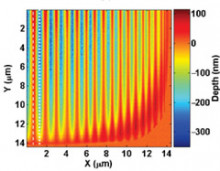
Ultrafast Laser Processing Modelling
Activities-challenges:
- Physical modelling of multiscale processes
- Investigation of surface modification mechanisms in (sub)-ablation and sub-melting conditions in various types of materials (i.e. semiconductors, metals, dielectrics),
- Interpretation of mechanisms that account for Laser Induced Periodic Surface Structures (LIPSS),
- Exploration of carrier dynamics in multilayered materials,
- Role of non-thermal electrons and out-of-equilibrium excited carriers
- Density Functional Theory (DFT)-based calculations of optical properties, excitation conditions, relaxation processes
- Strain propagation and surface modification at different laser polarization states,
- Ultrafast dynamics at mid-IR,
- Modelling Patterning processes through Direct Laser Interference techniques,
- Machine learning based approaches,
- Role of electromagnetic modes in LIPSS formation.
- Surface modification: A desirable effect in the laser-mater processing applications is to control and influence the morphology of the material surface by regulating the way of energy delivery from the laser into the various degrees of freedom of the system. Femtosecond pulsed laser interaction with matter triggers a variety of timescale-dependent processes, influenced by the fluence and pulse duration. A multiscale theoretical investigation is pursued to describe the physical fundamentals and mechanisms that account for the associated experimental observations after single and multiple-pulse ultrashort pulse irradiation and provide a systematic and controllable way of linking the observed surface modification with the applied conditions [1,2,3].
Although surface patterning has been previously investigated upon irradiation with ultrashort pulses in ablation conditions, physics fundamentals of surface modification and a novel surface patterning mechanism for ultrashort pulses have never been addressed in conditions near evaporation (sub-ablation). More specifically, we suggested a new physical mechanism that governs surface patterning formation (i.e. ripples) based on a combination of interference effects (and development of surface plasmon waves) coupled with hydrodynamics capillary induced effects and the dynamics of a superheated liquid layer. The ripple periodicity and morphological changes appear to agree satisfactorily with experimental observations. The model has been revised to allow the description of supra-wavelength structures (grooves) that result from the formation of hydrothermal convection rolls (Fig.1,2). Experimental results supported with theoretical simulations of the underlying physical processes manifest the universality of the mechanisms regardless of the type of the material (Fig.1).
Figure 1: SEM picture, and Simulation results.
Figure 2: (a) hydrothermal waves, (b) convection rolls
- Surface modification for complex polarization states: An extension of the model has been performed to explore the role of laser polarization. More specifically, radial and azimuthal polarisation were considered to elaborate on the effect on the ripple periodicity in various materials (Fig.3 shows subwavelength structure formation in fused silica) [4,5].
Figure 3: Rippled profile with a radially (a,c) and azimuthally (b,d) polarized beam
- Tailoring Sub-micrometer Periodic Surface patterning via Ultrashort Pulsed Direct Laser Interference Patterning (DLIP):
Direct laser Interference Patterning (DLIP) with ultrashort laser pulses (ULP) represents a precise and fast technique to produce tailored periodic sub-micrometer structures on various materials. An experimental and theoretical approach is pursued to investigate the previously unexplored fundamental mechanisms for the formation of unprecedented laser-induced topographies on stainless steel following proper combinations of DLIP with ULP (Figure 4). Special emphasis is given to electron excitation, relaxation processes and hydrodynamical effects that are crucial to the production of complex morphologies. Results are expected to derive new knowledge of laser-matter interaction in combined DLIP and ULP conditions and enable enhanced fabrication capabilities of complex hierarchical sub-micrometer sized structures for a variety of applications. In addition to reveal the impact of the laser beams used and their polarization, two beams are used, one Gaussian and another two- (or four-) beam DLIP of varying polarization (vertical or horizontal). Results indicate that the aforementioned parameters as well as the sequence order of the two pulses play a very important role in the attained topography [6,7].
Figure 4: Patterned profile based on DLIP technique with a two (A) and four (B) laser DLIP beam. Patterned surface is illustrated for single or two delayed pulses. Experimental results are interpreted through simulations.
Figure 5: Patterned profile based on a combination of two delayed (one Gaussian beam and one four beam DLIP) pulses. Experimental results are interpreted through simulations.
- Out-of-equilibrium electron dynamics and impact to mechanical effects: The significant influence of the contribution of the dynamics of produced nonthermalised electrons to electron thermalisation and electron-phonon interaction is also thoroughly investigated within a range of values of the pulse duration. The consideration of the role of the nonthermal electrons in the thermalisation of the lattice leads to thermomechanical changes compared to the results the traditional Two Temperature Model (TTM) provides (Fig.6) [8].
Figure 6: (a) Electronic and lattice temperature profile using the classical TTM and revised TTM, (b) Spatial strain profile simulated TTM and rTTM.
- Out-of-equilibrium electron dynamics: a unification of a DFT approach+ TTM model: To highlight the role of out-of-equilibrium processes for very short pulses a coupling of results from DFTcalculations (evaluation of optical properties) and the classical TTM has been performed to assess the influence of nonthermal electrons in surface damage in 6H-SiC (Fig. 7) [9].
Figure 7: (a) Reflectivity as a function of the photon energy through DFT calculations, (b) coupling of DFT calculations with TTM to compute carrier density evolution for 6H-SiC.
- Ultrafast dynamics and surface modification related effects for mid-IR femtosecond pulses: A detailed theoretical framework was also presented to describes both the ultrafast dynamics and thermal response following irradiation of Silicon [10]/fused silica [11] with ultrashort pulsed lasers in the mid-IR range (Fig.8,9). Results for Silicon demonstrated that the Kerr effect is important at lower wavelengths (~2.2 μm) while it leads to substantially large deviations to the maximum lattice temperature reached that it affects the damage threshold. A systematic analysis of the Surface Plasmon dispersion relation for mid-IR revealed that irradiation in the mid-IR region yielded SP that are weakly confined on the surface, exhibit longer lifetimes, and propagate on larger areas. These features can be potentially exploited to promote mid-IR-based technology to produce sensors, detectors or to present new capabilities in laser-based manufacturing.
Figure 8: Irradiation of Silicon with mid-IR femtosecond pulses
A multiscale modelling approach is performed that correlates conditions for formation of perpendicular or parallel to the laser polarisation low spatial frequency periodic surface structures for low and high intensity mid-IR pulses (not previously explored in dielectrics at those wavelengths), respectively. Results demonstrate a remarkable domination of tunneling effects in the photoionisation rate and a strong influence of impact ionisation for long laser wavelengths. The methodology presented in this work is aimed to shed light on the fundamental mechanisms in a previously unexplored spectral area and allow a systematic novel surface engineering with strong mid-IR fields for advanced industrial laser applications.
Figure 9: Irradiation of Fused SilIica with mid-IR femtosecond pulses
- Machine learning-based approaches: Recently, a new activity has been initiated in which machine learning based approaches and predictive modelling are followed to reduce the number of simulated and real experiments towards determining the laser parameters required to pattern surfaces with morphological features (i.e. ripples, grooves, spikes) required to provide desired functionalities an properties (i.e. antireflective, antifouling, antimicrobial, wetting, etc.) (Fig.10). Simulated data based on physics modelling (Fig.9a) and experimental data (Fig.10b) were used to automate and forecast the effect of laser processing on material structures. The focus is centered on the performance of representative statistical and machine learning algorithms in predicting the outcome of laser processing on a range of materials. Results on experimental data showed that predictive models were able to satisfactorily learn the mapping between the laser’s input variables and the observed material structure. These results are further integrated with simulation data aiming to elucidate the multiscale physical processes upon laser–material interaction. As a consequence, we augmented the adjusted simulated data to the experiment and substantially improved the predictive performance due to the availability of an increased number of sampling points. In parallel, an information-theoretic metric, which identifies and quantifies the regions with high predictive uncertainty, is presented, revealing that high uncertainty occurs around the transition boundaries. Our results can set the basis for a systematic methodology toward reducing material design, testing, and production cost via the replacement of expensive trial-and-error based manufacturing procedures with a precise pre-fabrication predictive tool [12].
Figure 10: (a) Simulated data based on physics modelling, (b) experimental data, (c-d) Machine learning based approaches results. Stainless steel is used as a test material.
- Prepatterned surfaces: The efficiency of light coupling to surface plasmon polariton (SPP) represents a very important issue in plasmonics and laser fabrication of topographies in various solids. To illustrate the role of pre-patterrned surfaces and impact of laser polsarisation in the excitation of electromagnetic modes and periodic pattern formation, Nickel surfaces are irradiated with femtosecond laser pulses of polarisation perpendicular or parallel to the orientation of the pre-pattern ridges. Experimental results indicate that for polarisation parallel to the ridges, laser induced periodic surface structures (LIPSS) are formed perpendicularly to the pre-pattern with a frequency that is independent of the distance between the ridges and periodicities close to the wavelength of the excited SPP. These results are also predicted from simulations (Fig.11). By contrast, for polarisation perpendicular to the pre-pattern, the periodicities of the LIPSS are closely correlated to the distance between the ridges for pre-pattern distance larger than the laser wavelength. The experimental observations are also interpreted through a multi-scale physical model in which the impact of the interference of the electromagnetic modes is revealed (Figure 12).
Figure 11 . Topography following irradiation of Nickel with fifteen laser pulses at 1026 nm (a) Upper view, (b) Side view.Polarisation is along the Y-axis.
Figure 12: . Spatial profile of the energy distribution for one, two, three pulses. The fourth figure illustrates the final topography (side view)
The pre-pattern periods and wavelengths studied here are (a-d) Λ=700nm with λ=513nm, (e-h) Λ=1400nm with λ=513nm, (i-l) Λ=1300nm with λ=1026nm, (m-p) Λ=1900nm with λ=1026nm. As seen from the above pre-pattern configurations, for Λ nearly as twice as the laser wavelength in (d-h) and (m-p), the electromagnetic intensity is accumulated on four locations within the pre-pattern valley. Electromagnetic modes restricted between the pre-pattern ridges produce temperature elevations and production of melt while the temperature gradients induce movement of the melting. Thus two hills emerge inside the pre-pattern valley with periodicity ~Λ/4 apart. Similarly for Λ comparable to the laser wavelength (a-d) and (i-l) the electromagnetic energy is accumulated on two regions within the pre-pattern valley which in turn melt material movement and re-solidification produce one hill in the middle of the valley forming Λ/2 periodicity. For Λ periodicities nearly less than the laser wavelength. The above numerical results confirm the LIPSS periodicity dependence on then pre-pattern period in good agreement with experimental results.
- Damage threshold evaluation and optical parameters in thin films: The employment of femtosecond pulsed lasers has received significant attention due to its capability to facilitate fabrication of precise patterns at the micro- and nano- lengths scales. A key issue for efficient material processing is the accurate determination of the damage threshold that is associated with the laser peak fluence at which minimal damage occurs on the surface of the irradiated solid. Despite a wealth of previous reports that focused on the evaluation of the laser conditions that lead to the onset of damage, the investigation of both the optical and thermal response of thin films of sizes comparable to the optical penetration depth is still an unexplored area. In this report, a detailed theoretical analysis of the impact of various parameters such as the photon energies and material thickness on the damage threshold for various metals (Au, Ag, Cu, Al, Ni, Ti, Cr, Stainless Steel) is investigated (Figure 13). A multiscale physical model is used that correlates the energy absorption, electron excitation, relaxation processes and minimal surface modification which leads to the onset of material damage. The satisfactory agreement of the theoretical model with some experimental results indicates that the damage threshold evaluation method could represent a systematic approach towards designing efficient laser-based fabrication systems and optimizing the processing outcome for various applications [13].
Figure 13: Reflectivity (left column), Absorbance (middle column) and damage threshold evaluation (right column) following irradiation of Al, Ni, Cr with fs laser pulses of two different photon energies (λL=515 nm and λL=1026 nm).
j. The synergy of electromagnetic effects and thermophysical properties of metals in the formation of laser induced periodic surface structures: Femtosecond pulsed lasers have been widely used over the past decades for precise materials structuring at the micro- and nano- scales. In order, though, to realize efficient material processing and account for the formation of laser induced periodic surfaces structures (LIPSS), it is very important to understand the fundamental laser-matter interaction processes. Significant contribution to the LIPSS profile appears to originate both from the electromagnetic fingerprint of the laser source and the thermal response of the material. In this work, we follow a systematic, step-by-step approach to predict the formation of LIPSS on metals due to the development of a spatially periodic energy deposition that results from the interference of electromagnetic far fields on a non-flat surface profile. We also demonstrate that the electromagnetic effects, alone, are not sufficient to allow the LIPSS formation, therefore, we emphasize on the crucial role of electron diffusion and electron-phonon coupling on the formation of stable periodic structures. Gold and stainless Steel are considered as two materials to test the theoretical model while simulation results appear to confirm the experimental results that, unlike gold, fabrication of pronounced LIPSS on stainless Steel is feasible (Figure 14) [14].
Figure 14: Absorbed energy distributions on the transverse plane for Au (a) and SS (b) surfaces. (c), (d) illustrate the Fourier transform of (a), (b), respectively. The green circles represent the boundary of ![]() where stands for the wave-vector of light propagation in air (double headed arrow indicates laser polarization direction). (e) and (f) illustrate normalized Z-component of the electric field at the propagation plane XZ. (double-headed arrows indicates laser polarization direction). In this cross section, two nano-holes are located at positions X=-2540 nm and X=1630 nm. The white line represents the air-metal interface.
where stands for the wave-vector of light propagation in air (double headed arrow indicates laser polarization direction). (e) and (f) illustrate normalized Z-component of the electric field at the propagation plane XZ. (double-headed arrows indicates laser polarization direction). In this cross section, two nano-holes are located at positions X=-2540 nm and X=1630 nm. The white line represents the air-metal interface.
Project Members
- Theory
- Dr George.D.Tsibidis (Modelling of laser-matter Interactions)
- Dr Panos Lingos (Electromagnetic Simulations)
- Dr Leonidas Mouchliadis (Density Functional Theory calculations)
- Maria-Christina.Velli (Modelling of laser-matter Interactions+Machine learning-based approaches)
- Experiment
- Dr Fotis Fraggelakis (Experiment)
- Dr Stella Maragkaki (Experiment)
- Dr Ioanna Sakelari (Experiment)
- Dr Dimitris Mansour (Experiment)
- Matina Vlahou (Experiment)
- Dr Emmanuel Stratakis (Experiment-Group Leader)
Representative publications
- Tsibidis G.D., Barberoglou M., Loukakos P.A., Stratakis E., and Fotakis C. (2012) ‘Dynamics of ripple formation on silicon surfaces by ultrashort laser pulses in subablation conditions’, Physical Review B, 86, 115316.
- Tsibidis G.D., Skoulas E., A.Papadopoulos, and Stratakis E. (2016), ‘Convection roll-driven generation of supra-wavelength periodic surface structures on dielectrics upon irradiation with femtosecond pulsed lasers’, Physical Review B (Rapid Communications) 94, 081305.
- Tsibidis G.D., Fotakis C., and Stratakis E. (2015), ‘From ripples to spikes: a hydro-dynamical physical mechanism to interpret femtosecond laser induced self-assembled structures’, Physical Review B (Rapid Communications), 92 ,041405.
- Tsibidis G.D., Skoulas E., and Stratakis E. (2015) “Ripple formation on Nickel irradiated with radially polarized femtosecond beams’, Optics Letters, 40 (22), 5172.
- Papadopoulos A., Skoulas E., Tsibidis G.D, and Emmanuel Stratakis E., ‘Formation of periodic surface structures on dielectrics after irradiation with laser beams of spatially variant polarisation: a comparative study’, Applied Physics A 124, 146 (2018).
- Fraggelakis F., Tsibidis G.D., Stratakis E., ‘Tailoring Sub-micrometer Periodic Surface Structures via Ultrashort Pulsed Direct Laser Interference Patterning’, Physical Review B 103, 054105 (2021).
- Fraggelakis F., Tsibidis G.D., Stratakis E., ‘Ultrashort pulsed laser induced complex surface structures generated by tailoring the melt hydrodynamics’, Opto-Electronic Advances, 5 210052 (2022), (Front Cover of Issue).
- Tsibidis G.D. (2018), ‘Ultrafast dynamics of non-equilibrium electrons and strain generation under femtosecond laser irradiation of Nickel’, Applied Physics A, 124,311.
- Mouchliadis L., Pedio M., Stratakis E., ‘Modelling ultrafast out-of-equilibrium carrier dynamics and relaxation processes upon irradiation of hexagonal Silicon-Carbide with Tsibidis G.D., femtosecond laser pulses’, Physical Review B 101, 075207 (2020).
- Petrakakis E., Tsibidis G.D., and Stratakis E., ‘Modelling of the ultrafast dynamics and surface plasmon properties of silicon upon irradiation with mid-IR femtosecond laser pulses’, Physical Review B 99, 195201 (2019).
- Tsibidis G.D., Stratakis E., ‘Ionization processes and laser induced periodic surface structures in dielectrics with mid-infrared femtosecond laser pulses’ Scientific Reports 10, 8675 (2020).
- Velli MC, Tsibidis G.D., Mimidis A., Skoulas E., Pantazis Y., Stratakis E., ‘Predictive modeling approaches in laser-based material processing’, Journal of Applied Physics, 28 183102 (2020).
- Tsibidis GD, Mansour D., Stratakis E., ‘Damage threshold evaluation of thin metallic films exposed to femtosecond laser pulses: the role of material thickness’ (submitted arXiv:2205.05342).
- Tsibidis GD, Lingos P., Stratakis E., ‘The synergy of electromagnetic effects and thermophysical properties of metals in the formation of laser induced periodic surface structures’ (submitted arXiv:2206.02351).
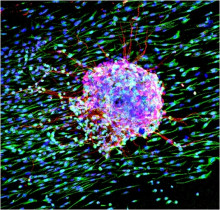
Direct Laser Fabrication of Biomimetic, 3D Scaffolds for Tissue Regeneration
Short Description and Main Findings of the Research Topics:
Research Topic 1: Direct Laser Micro/Nano Fabrication of Biomimetic Scaffolds
Short description
The aim is to investigate the biocompatibility of laser-engineered biomimetic 3D scaffolds fabricated on hard metallic and soft polymeric materials, exhibiting different micro/nano topographies and surface energies.
Abstract
The extracellular matrix provides the necessary cues at micro and nano-scale for cell adhesion, alignment, proliferation and differentiation. In this context, the surface topography of biomaterials can have an important impact on cellular adhesion, growth and proliferation. Apart from the overall roughness, the detailed morphological features, at all length scales, significantly affect the cell-biomaterial interactions in a plethora of applications including structural implants, tissue engineering scaffolds and biosensors.
The main objective is to investigate the biocompatibility of laser-engineered biomimetic 3D scaffolds fabricated on hard metallic and soft polymeric materials, exhibiting different micro/nano topographies and surface energies. Ultrafast pulsed laser irradiation is considered as a simple, precise and effective microfabrication method to produce structures of controlled geometry and pattern regularity. The variation of irradiation parameters, such as fluence and irradiation environment gives rise to significant changes of the surface morphology attained (i.e. geometry, dimensions and density of the structures). As a consequence, morphologies ranging from microcones to nanoripples (Figure 1), as well as hierarchical micro/nano structures (Figure 2) can be fabricated and further used as cell culture platforms.
The laser fabricated scaffolds with controlled surface roughness, wettability and surface energy can be used as model platforms to study the influence of topography on cell response. It is demonstrated that, depending on the laser processing conditions, distinct cell-philic or cell-repellant patterned areas can be attained with a desired motif (Figure 3). Laser processing could thus enable spatial patterning of cells in a controllable manner, giving rise to advanced capabilities in cell biology research.
Research has shown that cell adhesion and migration could be tuned via the laser-patterned substrates. It was also shown that microconical substrates could influence sympathetic and sensory neuronal alignment as well as NGF-induced PC12 cell differentiation (see also Research Topic 2).
Scaffolds on hard materials
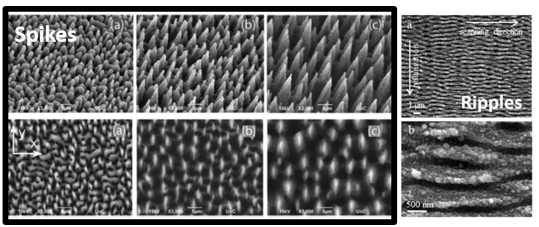
Figure 1: Various types of femtosecond laser fabricated scaffolds on hard materials with feature sizes ranging from a few hundreds of nanometers to tens of microns (C Simitzi, P Efstathopoulos, A Kourgiantaki, A Ranella, I Charalampopoulos, C Fotakis, I Athanassakis, E Stratakis, A Gravanis, Biomaterials, 2015, 67: 115-128, doi.org/10.1016/j.biomaterials.2015.07.008).

Figure 2: Laser fabricated arrays of biomimetic hierarchical micro/nano conical structures(Chara Simitzi, Pascal Harimech, Syrago Spanou, Christina Lanara, Amelie Heuer-Jungemann, Aleka Manousaki, Costas Fotakis, Anthi Ranella, Antonios G Kanaras, Emmanuel Stratakis, Biomater. Sci., 2018,6,1469, doi: 10.1039/c7bm00904f)
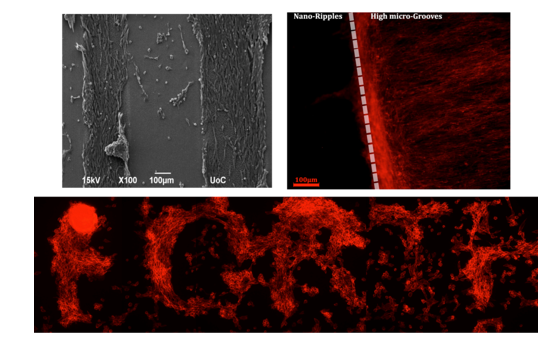
Figure 3: Patterning of Schwann (SW10) cells cultured on laser fabricated substrates exhibiting cell-philic and cell-repellant areas (Ch Yiannakou, Ch Simitzi, A Manousaki, C Fotakis, A Ranella, E Stratakis, 2017 Biofabrication 9 025024, https://doi.org/10.1088/1758-5090/aa71c6)
Scaffolds on soft materials
a) Replicated Scaffolds
Soft lithography has been successfully used to transfer well-defined micro-sized patterns from hard materials to soft (bio)materials. The replication of micro/nano topographies is realised on polymeric systems, such as poly (lactic-co-glycolic acid) (PLGA), polycaprolactone (PCL) (Figure 4) and polydimethylsiloxane (PDMS), in order to investigate the effect of material surface energy and stiffness on cellular responses (adhesion, proliferation, survival, growth and differentiation).
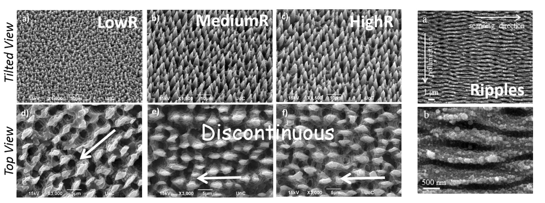
Figure 4a: SEM images (tilted view) of PLGA replicas with the hierarchical (microcone-spikes and nano-ripples) topographies (Babaliari, E., Kavatzikidou, P., Angelaki, D., Chaniotaki, L., Manousaki, A., Siakouli-Galanopoulou, A., Ranella, A., & Stratakis, E. (2018). Engineering Cell Adhesion and Orientation via Ultrafast Laser Fabricated Microstructured Substrates. International journal of molecular sciences, 19(7), 2053, doi: 10.3390/ijms19072053).

Figure 4b: SEM images (tilted view) of PCL replicas exhibiting various microcone topographies.
b) 3D scaffolds of porous collagen via subtractive laser manufacturing:
Laser micromachining provides a novel CAD/CAM rapid prototyping microfabrication process that can provide complex implant designs based on an established biomaterial utilized in clinical practice. It is shown that fs laser micromachining of porous collagen (Figure 5), in particular, can fabricate high-precision micron-sized features (e.g. canals, wells) and provides novel ways to modulate the microenvironment felt by interacting cells, tailor implants to the needs of individual patients, or tools to meet the current major challenges of regenerative medicine.
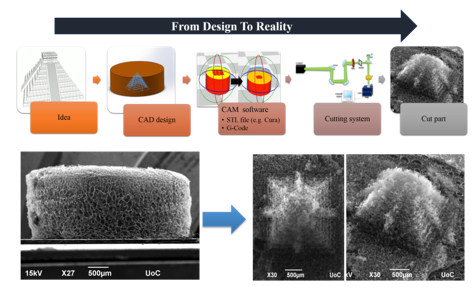
Figure 5: fs laser micromachining of porous collagen scaffolds
Research Topic 2: 3D Scaffolds Hosting Neurons and Neural Stem Cells
Short Description
The aim is to develop laser-engineered micro/nano scaffolds (3DLS) for hosting 3D cultures of neural stem cells.
Abstract
Neural stem cells (NSCs) are intrinsically capable of differentiating into different neural cell types: neurons, oligodendrocytes and astrocytes, and have emerged as important players in the generation and maintenance of neural tissue as well as in treating neurodegenerative diseases and neurological injuries. However, successful development of NSC-based therapies requires more sophisticated technologies from the ones that are already available and deeper understanding of NSCs’ functions. The NSCs reside in a complex three-dimensional (3D) niche in vivo where they are exposed to a plethora of signals, including physical signals such as tensile, compressive and shear stresses, discontinuities and differences in roughness of the ECM molecules. Topography is capable of inducing different effects on NSCs, such as changes in cell morphology, alignment (Figures 1 and 2), adhesion, migration, proliferation, cytoskeleton organization and also differentiation (Figure 3). However, simulating this 3D environment for NSC culture and subsequent development of 3D neuronal networks that maintain functional neuronal properties (synaptogenesis and neurotrophic performance) remains a challenge.
To respond to this challenge we have fabricated 3D laser-engineered micro/nano scaffolds (3DLS) featuring different micro/nano topographies for hosting neurons, glia and NSCs. These are advantageous platforms to study the biology of NSC proliferation, differentiation, neuritogenesis and synaptogenesis. Patterning of neuronal outgrowth in vitro is important in tissue engineering as well as for the development of neuronal interfaces with desirable characteristics. Laser-patterned biomimetic scaffolds could potentially be a useful platform for patterning neurons into artificial networks, allowing the study of neuronal cells interactions under 3D ex-vivo conditions.
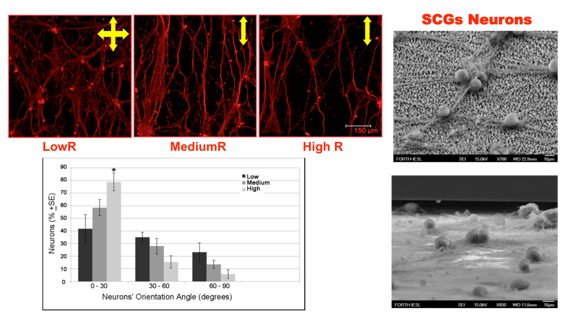
Figure 1: SCGs neurons orientation on laser fabricated discontinuous anisotropic microconical substrates (C Simitzi, P Efstathopoulos, A Kourgiantaki, A Ranella, I Charalampopoulos, C Fotakis, I Athanassakis, E Stratakis, A Gravanis, Biomaterials, 2015, 67: 115-128, doi.org/10.1016/j.biomaterials.2015.07.008).
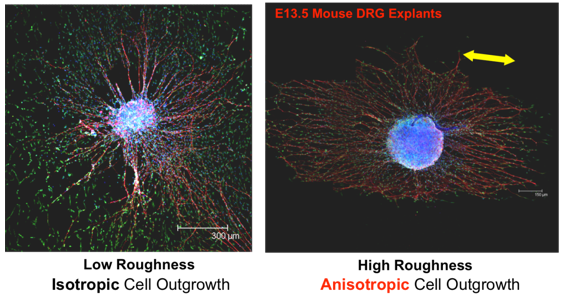
Figure 2: DRG cultures on laser fabricated discontinuous anisotropic microconical substrates (C Simitzi, P Efstathopoulos, A Kourgiantaki, A Ranella, I Charalampopoulos, C Fotakis, I Athanassakis, E Stratakis, A Gravanis, Biomaterials, 2015, 67: 115-128, doi.org/10.1016/j.biomaterials.2015.07.008).

Figure 3: Effect of surface roughness on PC12 cell differentiation. (C. Simitzi, E. Stratakis, C. Fotakis, I. Athanassakis and A. Ranella, Microconical silicon structures influence NGF-induced PC12 cell morphology, J Tissue Eng Regen Med2015;9: 424–434, DOI:10.1002/term.1853)
Research Topic 3: Development of microfluidic systems for cell studies under dynamic culture conditions
Understanding the cell-biomaterial interaction under dynamic culture conditions, in vitro, is potentially useful in the fields of tissue engineering and regenerative medicine.
A precise flow controlled microfluidic system with specific custom-designed chambers, incorporating laser-microstructured polyethylene terephthalate (PET) substrates comprising microgrooves, is developed to assess the combined effect of shear stress and topography on cells’ behavior (Fig.1). Specifically the dynamic cultures are performed for the study of the cytoskeleton, directionality and proliferation of cells on micro-nano patterns. A comparison between static and dynamic cultures is always performed in combination with computational flow simulations to calculate accurately the shear stress values. The main findings demonstrate that wall shear stress gradients may be acting either synergistic or antagonistic depending on the substrates groove orientation relative to the flow direction (Fig.2, Fig.3).

Figure 1: Custom-designed Microfluidic System

Figure 2: Confocal images of SW10 cells cultured on the PET-Flat (a, b, c) or inside the MG of the PET-MG substrates (d-i), under static (a, d, g) or dynamic conditions, applying 200 (c, f, i) μL/min, on the third day of culture. The cytoskeleton of the cells is visualized with red color (Alexa Fluor® 680 Phalloidin) while the nuclei with blue color (DAPI). The direction of the flow was parallel (f) or perpendicular (i) to the microgrooves. The inset SEM images, framed by a yellow box, depict the geometry of microgrooves (paper under submission).

Figure 3: Directional polar plots of cells’ cytoskeleton: a) No flow, PET-Flat (black line) 200 μL/min, PET-Flat (blue line), b) No flow, PET-MG (green line) - 200 μL/min parallel to MG, PET-MG (turquoise line), c) No flow, PET-MG (green line) - 200 μL/min perpendicular to MG, PET-MG (dark blue line). The black and red arrows represent the direction of the flow and the microgrooves, respectively.
Moreover, an additional microfluidic chamber incorporating polymeric microgrooved substrates that could be inserted to a non-linear microscope for live imaging observation is developed for nanotoxicology studies. The effect of nanoparticles on cells is examined in terms of survival and proliferation both under static and dynamic conditions (Fig.4).
Figure 4: Observation of live NIH 3T3 cells cultured on PDMS flat and microgrooved substrates with ZnO NPs inside the microfluidic chamber, under static conditions, with the NLO microscope. Scale bar: 10 μm.
In collaboration with Mary Kefalogianni and Dr. Sotiris Psilodimitrakopoulos
Selected Publications:
-
C. Simitzi, E. Stratakis, C. Fotakis, I. Athanassakis and A. Ranella, J Tissue Eng Regen Med, 2015;9: 424–434, DOI:10.1002/term.1853
-
Ch Yiannakou, Ch Simitzi, A Manousaki, C Fotakis, A Ranella, E Stratakis, 2017 Biofabrication 9 025024, doi: 10.1088/1758-5090/aa71c6
-
C. Simitzi, A. Ranella, E. Stratakis, Acta Biomaterialia, Volume 51, 15 March 2017, Pages 21-52, doi: 10.1016/j.actbio.2017.01.023.
-
Chara Simitzi, Pascal Harimech, Syrago Spanou, Christina Lanara, Amelie Heuer-Jungemann, Aleka Manousaki, Costas Fotakis, Anthi Ranella, Antonios G Kanaras, Emmanuel Stratakis, Biomater. Sci., 2018,6,1469, doi: 10.1039/c7bm00904f
-
Babaliari, E., Kavatzikidou, P., Angelaki, D., Chaniotaki, L., Manousaki, A., Siakouli-Galanopoulou, A., Ranella, A., & Stratakis, E. (2018). International journal of molecular sciences, 19(7), 2053, doi: 10.3390/ijms19072053
Main research expertise of the LaBio team:
Main medical applications: neural implants, bone implants, corneal implants, drug delivery etc
Project Members:
Alumni of the Subgroup
In collaboration with the following members:
• Dr. Sotiris Psilodimitrakopoulos
• Dr. Athanasia Kostopoulou
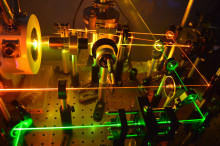
2D Materials
Abstract:
The research topic aims at the Investigation and Engineering of the optoelectronic properties of two-dimensional (2D) materials.
Two-dimensional Transition Metal Dichalcogenides MX2 (M=Mo, W and X=S, Se, Te) are of keen interest for emerging optoelectronic and valleytronic applications. The main activities in our lab focus on the optical response of 2D layered materials and their heterostructures. Spectroscopic techniques such as μ-PL, μ-Reflectance, and Raman are used to characterize the samples from 4K to 300K. We investigate how the degree of valley polarization (VP)-under resonant and non-resonant conditions-is affected by the dielectric environment in different heterostructures such as MX2/h-BN, MX2/Graphene, as well as their corresponding encapsulated structures. Besides, a fast-photochemical doping technique was developed in our lab to sufficiently control the carrier density of a single MX2 layer by incorporating chlorine atoms on the surface. Photochlorination leads to a controllable modification of VP that is directly related to the total number of the active defect sites and consequently to the control of the non-radiative exciton lifetime. We also study the PL emission and VP of suspended MX2 in different configurations with respect to strain induced by patterned substrates. Suspended MX2 monolayers (near zero strain) display enhanced PL and absorption due to the absence of charged excitons.
Spectroscopy of 2D materials provide the principal knowledge towards the development of state-of-the-art optoelectronic and valleytronic devices.
Research topics:
- Fabrication of Graphene and other 2D materials
- Spectroscopy of 2D materials and their heterostructures
- Photochemical doping of Graphene and other 2D materials
- Optoelectronic properties of TMDs at different dielectric environments
- Transient Absorption Spectroscopy of 2D materials
Highlights:
- Spatially selective reversible charge carrier density tuning in WS2 monolayers via photochlorination
- Tunable charge carrier concentration of chlorine doped 1L-WS2
- The effect can be reversed upon continuous wave laser scanning of the monolayer in air
(a) Schematic representation of the process used for the photochlorination of TMDs. (b) Evolution of the Raman Spectra of WS2 monolayer with the photochlorination time shown in the inset; evolution of the out-of-plane vibrational mode A’1 (c) Evolution of the PL spectra of a 1L-WS2 at 78 K, with the photochlorination time. Evolution of the calculated electron density with the photochlorination time and the ratio of normalized intensities of the X and X− peaks as a function of the photochlorination time. (d) Reversal of the photochlorination effect upon CW laser rastering of the chlorine-doped area, indicated by the suppresion of the PL emission by the area assigned as C. (e) Electronic band structures of 1L-WS2 with Chlorine atoms filling S vacancies (left panel), with Chlorine atoms adsorbed on the basal plane (right panel).
I.Demeridou, I. Paradisanos, Yuanyue Liu, N. Pliatsikas, P. Patsalas, S. Germanis, N. T. Pelekanos,
W.A. Goddard III, G. Kioseoglou and E. Stratakis, 2D Materials 6.1 (2018): 015003.
- Tuning the valley polarization in WS2 monolayers with photochemical doping
- Controlled valley polarization via modifying the electron densities in the crystal lattice of chlorine doped 1L-
- Reduction of circular polarization is directly related to the increase of the non-radiative exciton lifetime (τNR) - Elimination of the defect sites in the crystal lattice
(a) Optical image of WS2/hBN (b) PL spectra at 4K excited with 543nm laser for different photochlorination times analyzed for σ+ (red) and σ- (blue) helicity. (c) Circular polarization as function of the photochlorination time at T=4K. (d) Temperature dependence of the circular polarization for the neutral exciton for the pristine sample (black points) and for photochlorination times 4s (red) and 20s (blue). (e) Transient Absorption spectra of the A-exciton for the photochlorinated WS2 (black) and the as-prepared WS2 (red) at 78K.
I.Demeridou, A. Papadopoulos, G. Kourmoulakis, L. Mouchliadis, E. Stratakis, & G. Kioseoglou, Applied Physics Letters 118.12 (2021): 123103.
- Prominent room temperature valley polarization in WS2/Graphene heterostructures grown by chemical vapor deposition
- The degree of valley polarization of WS2 is considerably influenced by the material type used to form the heterostructure.
- The interaction between WS2 and Graphene has a strong effect on the temperature dependent depolarization
- The observed low depolarization rate in the WS2/Gr heterostructure is attributed to the nearly temperature independent scattering rate
- Significant variations in the degree of polarization are also observed at 4K between the different heterostructure configurations
(a) Optical images of hBN/WS2/hBN and (b) WS2/Gr. (c) and (d) T-dependent valley polarization for X0 of hBN/WS2/hBN and WS2/Gr under 543 and 594 nm excitation, respectively.
I.Paradisanos, K. M. McCreary, D. Adinehloo, L. Mouchliadis, J. T. Robinson, Hsun-Jen Chuang, A. T. Hanbicki, V. Perebeinos, B. T. Jonker, E. Stratakis, and G. Kioseoglou, Applied Physics Letters 116.20 (2020): 203102.
- Room temperature observation of biexcitons in exfoliated WS2 monolayers
- We report on the existence of biexcitons in mechanically exfoliated WS2 flakes from 78K up to room temperature
- Performing temperature and power dependent PL measurements, we identify the biexciton emission channel through the superlinear behavior of the integrated PL intensity as a function of the excitation power density
- Neutral and charged excitons show a linear to sublinear dependence in the whole temperature range. From the energy difference between the emission channels of the biexciton and neutral exciton, a biexciton binding energy of 65–70meV is determined
(a) Temperature-dependent PL spectra under 3.8kW/cm2 excitation power density. (b) Integrated PL intensity of L, XX/D, X-, and X peaks for different excitation densities. The XX/D peak exhibits a superlinear relationship with a power law exponent of 1.4 for excitation densities higher than ~1 kW/cm2. (c) 3D plot showing the emission strength of the XX/D at different excitation densities, at 78K. With increasing the excitation power density the biexciton emission dominates the spectra.
I.Paradisanos, S. Germanis, N. T. Pelekanos, C. Fotakis, E. Kymakis, G. Kioseoglou, and E. Stratakis,
Applied Physics Letters 110.19 (2017): 193102.
- Spatial Non-Uniformity in Exfoliated WS2 Single Layers
- Spatial variation of exciton complexes across the surface of monolayers
- Neutral excitons and trions competition due to the presence of oxygen species
(a) Typical optical microscopy image of exfoliated WS2 flakes. (b) Fluorescence image of WS2 monolayer. The stronger PL emission originates from the edges, creating a “donut” effect. (c) Intensity profile across the flake, following the line scan of Fig. 1b. (d) PL spectra comparison of two different spots on the flake (inset of Figure 1d). The PL emission from the central area is dominated by charged exciton (trion) recombination (X–, at 1.97eV) while the emission from the edges is mainly due to the neutral excitons (X0 at 2.01eV).
I.Paradisanos, N. Pliatsikas, P. Patsalas, C. Fotakis, E. Kymakis, G. Kioseoglou and E. Stratakis, Nanoscale 8.36 (2016): 16197.
6.Suspended and Strained areas on a single monolayer WS2flake
- Realization of a control method to create suspended and strained areas on a single flake
- Full spectroscopic characterization (Raman, PL, Spin-Valley polarization and Reflectivity) is utilized to study the system
- Neutral excitons dominate the photoluminescence from the suspended areas in combination with decreased spin-valley polarization, attributed to reduced carrier density
- Towards realization and fabrication of multifunctional devices utilizing a single TMD layer
Collaborators
- Vasili Perebeinos, Department of Electrical Engineering, SUNY at Buffalo NY, USA
- Aubrey Hanbicki, Laboratory for Physical Sciences, University of Maryland, USA
- Kathleen M. McCreary, Naval Research Laboratory, USA
- John Parthenios, Principal Staff Scientist, FORTH/ICE-HT, Greece
- Konstantinos Papagelis, Department of Physics, Aristotle University of Thessaloniki, Greece
- Panos Patsalas, Department of Physics, Aristotle University of Thessaloniki, Greece
- Joe Christodoulides, Naval Research Laboratory, Washington, D.C
Publications
- Tuning the valley polarization in WS2 monolayers via control of active defect sites induced by photochemical doping
I.Demeridou, A. Papadopoulos, G. Kourmoulakis, L. Mouchliadis, E. Stratakis, & G. Kioseoglou, Applied Physics Letters 118.12 (2021): 123103.
- Prominent room temperature valley polarization in WS2/Graphene heterostructures grown by chemical vapor deposition
I.Paradisanos, K. M. McCreary, D. Adinehloo, L. Mouchliadis, J. T. Robinson, Hsun-Jen Chuang, A. T. Hanbicki, V. Perebeinos, B. T. Jonker, E. Stratakis, and G. Kioseoglou, Applied Physics Letters 116.20 (2020): 203102.
- Spatially selective reversible charge carrier density tuning in WS2 monolayers via photochlorination
I.Demeridou, I. Paradisanos, Yuanyue Liu, N. Pliatsikas, P. Patsalas, S. Germanis, N. T. Pelekanos,
W.A. Goddard III, G. Kioseoglou and E. Stratakis, 2D Materials 6.1 (2018): 015003.
- Room temperature observation of biexcitons in exfoliated WS2 monolayers
I.Paradisanos, S. Germanis, N. T. Pelekanos, C. Fotakis, E. Kymakis, G. Kioseoglou, and E. Stratakis,
Applied Physics Letters 110.19 (2017): 193102.
- Spatial Non-Uniformity in Exfoliated WS2 Single Layers
I.Paradisanos, N. Pliatsikas, P. Patsalas, C. Fotakis, E. Kymakis, G. Kioseoglou and E. Stratakis, Nanoscale 8.36 (2016): 16197.
- Intense Femtosecond Photoexcitation of bulk and monolayer MoS2
I.Paradisanos, E. Kymakis, C. Fotakis, G. Kioseoglou, and E. Stratakis, Appl. Phys. Lett., 105 (2014), 041108.
Project Members
Prof. George Kioseoglou & Dr. Emmanuel Stratakis
Dr. Sotiris Psilodimitrakopoulos
Dr. Leonidas Mouchliadis
Dr. Ioanna Demeridou
Mr. Antonis Papadopoulos
Mr. George Kourmoulakis
Ms. Eirini Katsipoulaki
Mr. George Maragkakis
Dr. Ioannis Paradisanos (Alumni)
Objective: The objective of this activity is the application of ultrafast laser time-resolved spectroscopy in the fields of photovoltaics, thermoelectric polymers, and plasmonic photocatalysts towards optimizing materials performance and expanding their applications.
Abstract: In Photovoltaics: Femtosecond time-resolved Transient Absorption Spectroscopy (TAS) is used for studying the fundamental photo-physics and decay dynamics in organic photovoltaics (OPVs) and perovskite solar cells (PSCs). Namely, TAS provides important insights on the charge carrier dynamics such as electron-hole injection times and exciton recombination rates that are well known to be directly correlated with the performance of the devices. Figure 1a presents a schematic representation of TAS experimental setup, while Figure 1b depicts a typical optical density (ΔOD) spectrum of a glass/ITO/PEDOT:PSS/CH3NH3PbI3 architecture as a function of wavelength and time from which the charge carrier dynamics are revealed upon following fitting analysis. Notably, the TAS setup in ULMNP Laboratory allows the performance of measurements under dry ambient, as well as, in-situ probing at variable temperatures. This part of the research activity is implemented by a joint effort between the ULMNP Group and the Nanomaterials and Organic Electronics Group of the Center of Materials Technology and Photonics (CEMATEP) of the Hellenic Mediterranean University (HMU), headed by Prof. Emmanuel Kymakis. Our continuous mission is to provide research facilities for state-of-the-art research in the multidisciplinary field of nanotechnology and advanced electronics. In brief the activity focuses on the following:
- Exploring the effect of hole transport layer on the charge transfer, carrier trapping and hole injection dynamics within PSCs.
- In-situ monitoring of the charge carrier dynamics of CH3NH3PbI3 perovskite during crystallization process.
- Transient photo-induced bleaching relaxation dynamics in OPVs.
- Correlation of charge carrier transport dynamics with electrical measurements towards enhancing device performance and stability.
Figure 1: (a) Schematic representation of TAS experimental setup. (b) Optical density (ΔOD) transient absorption spectra of a glass/ITO/PEDOT:PSS/CH3NH3PbI3 architecture.
In Thermoelectric Polymers: Along similar lines, the application of TAS technique is expanded to thermoelectric composite polypropylene-based polymers that contain carbon nanotubes (CNTs). The latter are responsible for generating electrical current upon exposure to temperature differentials. Recent data from our Laboratory reveal that TAS is powerful technique and a figure-of-merit method to explore ultrafast phenomena and relaxation processes that take place within these CNT composite polymers, and thus, providing important information for the design and development of novel configurations with enhanced thermoelectric performance (Figure 2). The characterization of thermoelectric polymers by means of TAS are implemented within the frame of the European project InComEss. Overall, the activity targets the following:
- Correlating exciton dynamics of single and hybrid CNT composite polymers with thermoelectric performance, towards the design of advanced energy scavenging devices.
Figure 2: Correlation of exciton dynamics and lifetimes with the thermoelectric performance of polypropylene-based polymer composites containing various types of carbon nanotubes (CNTs).
In Plasmonic Photocatalysts: The key objective of employing TAS in plasmonic photocatalysts such as CuFeS2 arises from the challenge to shed light on the mechanism of their catalytic action. It was found recently that CuFeS2 nanoparticles exhibit remarkable catalytic performance in terms of selectivity, speed, yield, and recyclability when it comes to the reduction of nitroarenes into the corresponding amines. This chemical process is of enormous importance in the field of chemical industry for the cost-effective production of polymers, pharmaceuticals, agrochemicals, and dyes. As revealed by TAS the success of the CuFeS2 nanoparticles relies on the generation of hot electrons and heat in both conduction and intermediate bands, while having suitable energy band gap with hydrazine (Figure 3). The research outcome of this activity was published in Nature Nanotechnology and with respect to TAS it focuses on:
- Insights into the mechanism of action of CuFeS2 catalyst for nitroarenes reduction.
Figure 3: (a) EDS chemical mapping of CuFeS2 nanoparticles. (b) Schematic representation of energy level diagrams of CuFeS2 catalyst and hydrazine. (c) Time-resolved transient absorption spectra of the CuFeS2 catalyst showing the optical density difference (ΔOD) as a function of wavelength at various time delays, along with the corresponding transient dynamics.
Active projects: InComEss, LASERGRAPH.
Contact persons: Dr. Ioannis Konidakis, Dr. Emmanuel Stratakis.
Project members: Dr. Ioannis Konidakis, Dr. Emmanuel Stratakis.
Project members Alumni: Prof. Costas Fotakis, Dr. Kyriaki Savva, Dr. Efthymis Serpetzoglou.
Collaborators: Prof. Emmanuel Kymakis (HMU), Dr. Petra Pötschke (IPF-Dresden), Dr. Aristides Bakandritsos (UPOL).
Selected publications:
1. “Fast and selective reduction of nitroarenes under visible light with an earth‑abundant plasmonic photocatalyst”, A.C. Poulose, G. Zoppellaro, I. Konidakis, E. Serpetzoglou, E. Stratakis, O. Tomanec, M. Beller, A. Bakandritsos and R. Zbořil, Nat. Nanotechnol. 17, 485 (2022).
2. “Charge carrier dynamics in different crystal phases of CH3NH3PbI3 perovskite photovoltaic active layer”, E. Serpetzoglou, I. Konidakis, G. Kourmoulakis, I. Demeridou, K. Chatzimanolis, C. Zervos, G. Kioseoglou, E. Kymakis and E. Stratakis, Opto-Electron. Sci. 1, 210005 (2022).
3. “Nitrogen-doped carbon nanotube/polypropylene composites with negative Seebeck coefficient”, B. Krause, I. Konidakis, M. Arjmand, U. Sandararaj, R. Fuge, M. Liebscher, S. Hampel, M. Klaus, E. Serpetzoglou, E. Stratakis and P. Pötschke, J. Compos. Sci. 4, 14 (2020).
4. “In situ monitoring of the charge carrier dynamics of CH3NH3PbI3 perovskite crystallization process”, E. Serpetzoglou, I. Konidakis, T. Maksudov, A. Panagiotopoulos, E. Kymakis and E. Stratakis, J. Mater. Chem. C 7, 12170 (2019).
5. Limitations of a polymer-based hole transporting layer for application in planar inverted perovskite solar cells”, M. Petrovic, T. Maksudov, A. Panagiotopoulos, E. Serpetzoglou, I. Konidakis, M.M. Stylianakis, E. Stratakis and E. Kymakis, Nanoscale Adv. 1, 3107 (2019).
6. “Improved charge carrier dynamics of CH3NH3PbI3 perovskite films synthesized by means of laser-assisted crystallization”, I. Konidakis, T. Maksudov, E. Serpetzoglou, G. Kakavelakis, E. Kymakis and E. Stratakis, ACS Appl. Energy Mater. 1, 5101 (2018).
7. “α,β-Unsubstituted meso-positioning thienyl BODIPY: a promising electron deficient building block for the development of near infrared (NIR) p-type donor-acceptor (D-A) conjugated polymers”, B.M. Squeo, V.G. Gregoriou, Y. Han, A. Palma-Cando, S. Allard, E. Serpetzoglou, I. Konidakis, E. Stratakis, A. Avgeropoulos, T.D. Anthopoulos, M. Heeney, U. Scherf and C.L. Chochos, J. Mater. Chem. C 6, 4030 (2018).
8. “Enhancement of the power-conversion efficiency of organic solar cells via unveiling an appropriate rational design strategy in indacenodithiophene-alt-quinoxaline π-conjugated polymers”, C.L. Chochos, R. Singh, V.G. Gregoriou, M. Kim, A. Katsouras, E. Serpetzoglou, I. Konidakis, E. Stratakis, K. Cho and A. Avgeropoulos, ACS Appl. Mater. Interfaces 10, 10236 (2018).
9. “Improved carrier transport in perovskite solar cells probed by femtosecond transient absorption spectroscopy”, E. Serpetzoglou, I. Konidakis, G. Kakavelakis, T. Maksudov, E. Kymakis and E. Stratakis, ACS Appl. Mater. Interfaces 9, 43910 (2017).
10. “The role of chemical structure in indacenodithienothiophene-alt-benzothiadiazole copolymers for high performance organic solar cells with improved photo-stability through minimization of burn-in loss”, C.L. Chochos, N. Leclerc, N. Gasparini, N. Zimmerman, E. Tatsi, A. Katsouras, D. Moschovas, E. Serpetzoglou, I. Konidakis, S. Fall, P. Leveque, T. Heiser, M. Spanos, V.G. Gregoriou, E. Stratakis, T. Ameri, C.J. Brabec and A. Avgeropoulos, J. Mater. Chem. A 5, 25064 (2017).
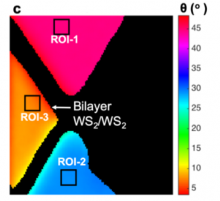
Applications of Non-Linear Imaging in Materials Science
Two-photon photoluminescence (2PL), polarization-resolved second-harmonic generation (P-SHG) and polarization-resolved third-harmonic generation (P-THG) imaging microscopy of non-linear materials.
The goal of the project is to employ 2PL imaging and precise polarization measurements of SHG, and THG signal and interpret the produced signals in order to gain further physical insight into nanomaterials (e.g. the graphene or the graphene related 2D materials).
Contact Person(s):
Dr. Emmanuel Stratakis
Dr. Sotiris Psilodimitrakopoulos
Research Topics
Non-linear optical properties of graphene and graphene related 2D materials
Abstract
Despite their similarities, 2PL, SHG and THG are based on fundamentally different phenomena. 2PL relies on nonlinear multiphoton absorption, followed by fluorescence emission while SHG relies on non-centrosymmetry and nonlinear scattering. Finally, THG originates from changes in the samples’ index of diffraction. The consequences of those basic differences are exploited and utilized in this project as new contrast mechanisms for characterizing nanomaterials of interest, e.g. the graphene and the graphene related 2D materials.
In particular, by varying the polarization angle of the excitation field and recording the second and third harmonic intensity, we are able to produce polar diagrams whose patterns are consequently connected with the crystal orientation, the relative orientation between different layers or even the way in which electrons are distributed among the available energy states of the system. Such a link is made possible through application of nonlinear optics and the derivation of equations for the SHG and THG intensity that are used to fit the experimental data and infer the values of interesting parameters such as the armchair orientation, the twist angle, the valley population imbalance etc.
The continuous interaction between theory and experiment within the Imaging subgroup offers an ideal means for enhancing our insight on the nonlinear phenomena occurring in organic and inorganic systems under intense laser light excitation and allows for both prognostics and diagnostics of 2D materials and biological samples.
Femtosecond laser raster-scanning microscopy imaging is used to study the nonlinear optical properties (second and third harmonic generation) of atomically thin materials.
Fully-motorized Polarization-Resolved Non-Linear Microscope
- Simultaneous, 2p and 3p Fluorescence/ PL, P-SHG and P-THG
- 5 simultaneous channels
- Polarization control in both excitation and detection
-Temperature dependent (78K-300K) measurements, using a cryostat at the sample plane
- Dual beam - Simultaneous dual raster-scanning
Experimental Setup
Mapping of the main crystallographic axis and crystal quality diagnostics in transition metal dichalcogenides
Polarization-resolved second harmonic generation (P-SHG) imaging is performed in monolayer transition metal dichalcogenides (TMDs), such as MoS2, WS2, MoSe2 and WSe2, to map the main cystallographic axis (armchair) , and evaluate the crystal quality.
- [“Imaging the crystal orientation of 2D transition metal dichalcogenides using polarization-resolved second-harmonic generation,” G. M. Maragkakis, S. Psilodimitrakopoulos, L. Mouchliadis, I. Paradisanos, A. Lemonis, G. Kioseoglou and E. Stratakis, Opto-Electronic Advances, 2, 190026 (2019).]
Ultra-high resolution Mapping of Armchair orientation
["Ultrahigh-resolution non-linear optical imaging of the armchair orientation in 2D transition metal dichalcogenides,"S. Psilodimitrakopoulos, L. Mouchliadis, I. Paradisanos, A. Lemonis, G. Kioseoglou and E. Stratakis, Light: Science & Applications, 7, 18005 (2018).]
Quantification of Crystal quality
["Ultrahigh-resolution non-linear optical imaging of the armchair orientation in 2D transition metal dichalcogenides,"S. Psilodimitrakopoulos, L. Mouchliadis, I. Paradisanos, A. Lemonis, G. Kioseoglou and E. Stratakis, Light: Science & Applications, 7, 18005 (2018).]
Twist angle mapping
The twist angle (the relative angle between stacked 2D monolayers) is a new degree of freedom in 2D materials, since its affects the physical properties of a multilayer structure. Here, we map the twist angle in TMD-based structures by performing P-SHG imaging and developing suitable SHG interference models.
Twist angle mapping in TMD homobilayers
- “Twist Angle mapping in layered WS2 by Polarization-Resolved Second Harmonic Generation,” S. Psilodimitrakopoulos, L. Mouchliadis, I. Paradisanos, G. Kourmoulakis, A. Lemonis, G. Kioseoglou and E. Stratakis, Scientific Reports, 9, 14285 (2019).]
Real-time twist angle imaging in TMD heterobilayers
- “Real-time spatially resolved determination of twist angle in transition metal dichalcogenide heterobilayers,” S. Psilodimitrakopoulos, L. Mouchliadis, G. M. Maragkakis, G. Kourmoulakis, A. Lemonis, G. Kioseoglou and E. Stratakis, 2D Materials 8, 015015, (2021).]
- “Real-time spatially resolved determination of twist angle in transition metal dichalcogenide heterobilayers,” S. Psilodimitrakopoulos, L. Mouchliadis, G. M. Maragkakis, G. Kourmoulakis, A. Lemonis, G. Kioseoglou and E. Stratakis, 2D Materials 8, 015015, (2021).]
Comparison between optical and electron diffraction imaging of twist-angle in 2D TMD bilayers
[“Optical versus electron diffraction imaging of twist-angle in 2D transition metal dichalcogenide bilayers” S. Psilodimitrakopoulos, A. Orekhov, L. Mouchliadis, D. Jannis, G. M. Maragkakis, G. Kourmoulakis, N. Gauquelin, G. Kioseoglou, J. Verbeeck and E. Stratakis, npj 2D Materials & Applications 5, 77, (2021).]
[“Optical versus electron diffraction imaging of twist-angle in 2D transition metal dichalcogenide bilayers” S. Psilodimitrakopoulos, A. Orekhov, L. Mouchliadis, D. Jannis, G. M. Maragkakis, G. Kourmoulakis, N. Gauquelin, G. Kioseoglou, J. Verbeeck and E. Stratakis, npj 2D Materials & Applications 5, 77, (2021).]
Probing valley population imbalance in TMDs with temperature-dependent SHG imaging
Degenerate minima in the bandstructure of TMDs—valleys—provide an additional degree of freedom that can be used for information transport and storage. When these atomically thin crystals interact with intense laser light, the emerging SHG inherits special characteristics that reflect not only the broken inversion symmetry in real space but also the valley anisotropy in reciprocal space. The temperature-induced change of the SHG intensity dependence on the excitation field polarization is a fingerprint of valley population imbalance in TMDs.
- "Probing valley population imbalance in transition metal dichalcogenides via temperature-dependent second harmonic generation imaging” L. Mouchliadis, S. Psilodimitrakopoulos, G. M. Maragkakis, I. Demeridou, G. Kourmoulakis, A. Lemonis, G. Kioseoglou & E. Stratakis, npj 2D Materials & Applications 5, 6, (2021).]
- "Probing valley population imbalance in transition metal dichalcogenides via temperature-dependent second harmonic generation imaging” L. Mouchliadis, S. Psilodimitrakopoulos, G. M. Maragkakis, I. Demeridou, G. Kourmoulakis, A. Lemonis, G. Kioseoglou & E. Stratakis, npj 2D Materials & Applications 5, 6, (2021).]
- "Probing valley population imbalance in transition metal dichalcogenides via temperature-dependent second harmonic generation imaging” L. Mouchliadis, S. Psilodimitrakopoulos, G. M. Maragkakis, I. Demeridou, G. Kourmoulakis, A. Lemonis, G. Kioseoglou & E. Stratakis, npj 2D Materials & Applications 5, 6, (2021).]
- "Probing valley population imbalance in transition metal dichalcogenides via temperature-dependent second harmonic generation imaging” L. Mouchliadis, S. Psilodimitrakopoulos, G. M. Maragkakis, I. Demeridou, G. Kourmoulakis, A. Lemonis, G. Kioseoglou & E. Stratakis, npj 2D Materials & Applications 5, 6, (2021).]
Third harmonic generation in 2D materials
THG imaging is performed in TMD-based structures in order to obtain complementary to second harmonic generation information about the crystal orientation and homogeneity.
Collaborators
Prof. Johan Verbeeck
Prof. Panos Patsalas
Prof. Andrey Turchanin
Dr. Maria Sygletou
Dr. Ioannis Paradisanos
Publications
- “Optical versus electron diffraction imaging of twist-angle in 2D transition metal dichalcogenide bilayers” S. Psilodimitrakopoulos, A. Orekhov, L. Mouchliadis, D. Jannis, G. M. Maragkakis, G. Kourmoulakis, N. Gauquelin, G. Kioseoglou, J. Verbeeck and E. Stratakis, npj 2D Materials & Applications 5, 77, (2021).
- 2. “Self-assembled dichroic plasmonic nitride nanostructures with broken centrosymmetry for second-harmonic Generation”, D. Babonneau, S. Camelio, G. Abadias, D. Christofilos, I. Arvanitidis, S. Psilodimitrakopoulos, G. M. Maragkakis, E. Stratakis, N. Kalfagiannis, and P. Patsalas,, ACS Applied Nano Materials 4, 9, (2021).
- "Probing valley population imbalance in transition metal dichalcogenides via temperature-dependent second harmonic generation imaging” L. Mouchliadis, S. Psilodimitrakopoulos, G. M. Maragkakis, I. Demeridou, G. Kourmoulakis, A. Lemonis, G. Kioseoglou & E. Stratakis, npj 2D Materials & Applications 5, 6, (2021).
- “Real-time spatially resolved determination of twist angle in transition metal dichalcogenide heterobilayers,” S. Psilodimitrakopoulos, L. Mouchliadis, G. M. Maragkakis, G. Kourmoulakis, A. Lemonis, G. Kioseoglou and E. Stratakis, 2D Materials 8, 015015, (2021).
- “Imaging the crystal orientation of 2D transition metal dichalcogenides using polarization-resolved second-harmonic generation,” G. M. Maragkakis, S. Psilodimitrakopoulos, L. Mouchliadis, I. Paradisanos, A. Lemonis, G. Kioseoglou and E. Stratakis, Opto-Electronic Advances, 2, 190026 (2019).
- “Twist Angle mapping in layered WS2 by Polarization-Resolved Second Harmonic Generation,” S. Psilodimitrakopoulos, L. Mouchliadis, I. Paradisanos, G. Kourmoulakis, A. Lemonis, G. Kioseoglou and E. Stratakis, Scientific Reports, 9, 14285 (2019).
- "Ultrahigh-resolution non-linear optical imaging of the armchair orientation in 2D transition metal dichalcogenides,"S. Psilodimitrakopoulos, L. Mouchliadis, I. Paradisanos, A. Lemonis, G. Kioseoglou and E. Stratakis, Light: Science & Applications, 7, 18005 (2018).
- "Effect of composition and temperature on the second harmonic generation in silver phosphate glasses" I. Konidakis, S. Psilodimitrakopoulos, K. Kosma, A. Lemonis, and E. Stratakis Optical Materials, 75, 796-801, (2018).
Media Coverage
1. LaserLab Cover (Issue 31, August 2021)
2. CretaLive Article (September 2021)
https://www.cretalive.gr/kriti/otan-ena-nompel-empneei-ereynites-toy-ite-kanoyn-thaymata
3.CretaLive Article (January 2021)
https://www.cretalive.gr/kriti/nompel-grafenio-i-nanotehnologia-kai-oi-ereynites-toy-ite
Project members
Dr. Emmanuel Stratakis
Prof. George Kioseoglou
Dr. Sotiris Psilodimitrakopoulos
Dr. Leonidas Mouchliadis
Mr. George-Miltos Maragkakis
Ms. Anna Koliofoti
Dr. Ioanna Demeridou
Mr. George Kourmoulakis
Dr. Abdus Salam Sarkar
Mr. Andreas Lemonis
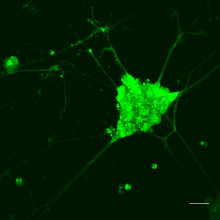
Advanced Bioimaging Modalities (2p and 3p fluorescence, P-SHG, P-THG and nano-surgery station)
Advanced (Non-linear) Imaging Microscopy Techniques for non-invasive, continuous observation of living cells and tissues.
The objectives of the project are to utilize non-invasive invasive, high-resolution, fs laser raster-scanning imaging microscopy and analysis methods through the systematic use of multiphoton excited fluorescence (2p and 3p), polarization-resolved second harmonic generation (P-SHG) and polarization-resolved third harmonic generation (P-THG), to quantitatively characterize the structure and function of living cells and tissues at video rates.
Contact Person(s):
Dr. Emmanuel Stratakis
Dr. Sotiris Psilodimitrakopoulos


Research Topics
Non-Linear Imaging Microscopy
Abstract
Critical insight and characterization of the fundamental nature of cellular and tissue function traditionally relies on detailed morphological information at the microscopic level. In recent years non-invasive invasive laser raster-scanning imaging techniques like MPEF (two-photon and three-photon), P-SHG and P-THG have emerged as new powerful high-resolution optical modalities for quantitative characterization of biological samples.
Both the above advanced optical microscopy techniques are based on minimally invasive fs laser irradiation and provide intrinsic z-sectioning due to signals nonlinear dependence on the excitation photon flux. Since the fs laser interaction is minimal, fairly nonlinear microscopy is considered as the most appropriate for live-imaging. It is based on signals originating from endogenous non-centrosymmeric molecular assemblies and lipids or on signals from exogenous species like fluorescence chromophores or nanoparticles to provide contrast. Furthermore, the infrared wavelengths used allow penetration depths (of several hundred microns into highly turbid tissues), unreachable by the common linear fluorescence or confocal microscopy.
By varying the polarization angle of the excitation field in collagen and myelin and recording the second and third harmonic intensity, respectively, we are able to produce polar diagrams whose patterns are consequently connected with the direction of the collagen and myelin molecules. Such a link is made possible through application of nonlinear optics and the derivation of equations for SHG and THG intensity that are used to fit the experimental data and infer the values of interesting parameters such as the collagen and myelin orientation and organization. This procedure allows to extract quantitative parameter values and establish a direct connection between the polarization state of the produced light and the health state of the corresponding cellular structure.
In particular, our studies on myelin, a cylindrical insulating sheath that forms around nerves, suggest that the nonlinear signal produced by mutant myelin samples differs dramatically from that of healthy ones and thus may be used as a diagnostic tool for myelin degeneration. During the theoretical treatment, myelin is approximated with a hexagonally symmetric crystal and analytical expressions are derived for the myelin third harmonic generation for both linear and circular excitation conditions.
The continuous interaction between theory and experiment within the Imaging subgroup offers an ideal means for enhancing our insight on the nonlinear phenomena occurring in organic systems under intense laser light excitation and allows for both prognostics and diagnostics of biological samples.
TPEF imaging in living neurons
2p-Calcium Imaging of neural aggregates.
Brain slices
Simultaneous two and three photon (2p-, 3p) excited fluorescence used to visualize and characterize live and fixed brain slices, either via the use of fluorescent dyes or by excitation of autofluorescence.
Live brain slice imaging setup
Brain slices, supplied with nutrients and oxygen in a special incubator placed at the sample plane of the microscope, are kept alive and healthy for hours during imaging, enabling the study of brain’s response to special conditions like hypoxia.
Live cell imaging
In the incubator (Ambient and living slices supporting medium temperature control, CO2 and O2 control) we can image cellular cultures for long periods, while by making collages of images we can study arbitrarily large areas with μm resolution.
Calcium imaging
Using fluorescent dyes the electrical activity of cellular cultures and tissue is recorded via 2-PEF, providing valuable information about their dynamical connectivity and condition.
Topological characterization and determination of neuronal network electrical connectivity
Polarization-resolved Second Harmonic Generation (P-SHG)
P-SHG has been used in our lab to visualize for the first time and optically characterize the evolution of collagen remodeling in collagen-based scaffolds seeded with live cells.
Polarization-resolved Third Harmonic Generation (P-THG)
Myelin is the THG signal source in Optical Neuron
COLOCALIZATION of THG and Alexa 488 from myelin
Polarization-Resolved Third Harmonic Generation
Collaborators
Prof. George Garinis
Prof. Kyriaki Sidiropoulou
Prof. Domna Garagogeos
Prof. Dimitris Tzeranis
Prof. Achilleas Gravanis
Dr. Katerina Gkirtzimanaki
Mrs. Constantina Georgelou
Mrs. Niki Ktena
Mrs. Fereniki Moschogiannaki
Publications
- "Three-dimensional characterization of collagen remodeling in cell-seeded collagen scaffolds via polarization second harmonic generation," Dionysios Xydias, Georgios Ziakas, Sotiris Psilodimitrakopoulos, Andreas Lemonis, Eleni Bagli, Theodore Fotsis, Achille Gravanis, Dimitrios S. Tzeranis, and Emmanuel Stratakis, Biomed. Opt. Express 12, 1136-1153, (2021).
- “Neural Stem Cell Delivery via Porous Collagen Scaffolds Promotes Neuronal Differentiation and Locomotion Recovery in Spinal Cord Injury” A. Kourgiantaki, D. S. Tzeranis, K. Karali, S. Psilodimitrakopoulos, M. Nikou, I. V. Yannas, E. Stratakis, K. Sidiropoulou, I. Charalampopoulos, A. Gravanis Nature Regenerative Medicine, 5, 12 (2020).
- “Ex vivo multiscale quantitation of skin biomechanics in wild-type and genetically-modified mice using multiphoton microscopy” Bancelin, B. Lynch, C. Bonod-Bidaud, G. Ducourthial, S. Psilodimitrakopoulos, P. Dokladal, J.-M. Allain, M.-C. Schanne-Klein, and F. Ruggiero, Scientific Reports 5, 17635 (2015).
- “Monitoring myosin conformational fast changes in-vivo with instantaneous single scan polarization-SHG microscopy” Psilodimitrakopoulos, D. Artigas, and P. Loza-Alvarez, Biomedical Opt. Express, 5, 4362 (2014).
- “Quantitative imaging of microtubule alteration as an early marker of axonal degeneration after ischemia in neurons” Psilodimitrakopoulos, V. Petegnief, N. de Vera, O. Hernandez, D. Artigas, A. M. Planas, and P. Loza-Alvarez, Biophys. J., 104, 968 (2013).
- “Femtosecond laser axotomy in Caenorhabditis elegans, and collateral damage assessment using a combination of linear and nonlinear imaging techniques” I.C.O. Santos, M. Mathew, O. E. Olarte, S. Psilodimitrakopoulos, and Pablo Loza-Alvarez, PLoS ONE, 8, e58600 (2013).
Project Members
Dr. Emmanuel Stratakis
Dr. Sotiris Psilodimitrakopoulos
Dr. Leonidas Mouchliadis
Mr. Dionysios Xydias
Mrs. Maria Kefalogianni
Mrs. Lida Vagiaki
Mr. Andreas Lemonis
Dr. Lina Papadimitriou
Dr. Anthi Ranella
Dr. Evi Kanatzikidou

Ultrafast Laser Synthesis of Nanomaterials and Device Components
Ultrafast laser processing is a promising tool for the fabrication of nanomaterials of different morphologies, as well as device components, for multiple applications ranging from solar cells and automotive sensors to biomedical devices.
Activities:
Ultrafast Laser Synthesis of Nanomaterials and Device Components
Ultrafast laser processing is a promising tool for the fabrication of nanomaterials of different morphologies, as well as device components, for multiple applications ranging from solar cells to biomedical devices. According these lines, two-dimensional (graphene-based) or other low-dimensional (MoS2 and WS2, fullerene-like and nanotubes) as well as perovskite nanostructures and device components can be fabricated.
Activities:
a) Laser fabrication of graphene-based materials and device components for photovoltaic and biomedical applications
Photochemical techniques have been introduced for the fabrication and modification of graphene-based materials for the enhancement of the photovoltaic devices’ performance. These materials can be used in organic electronics, particular to organic photovoltaics, field effect transistors and electron emission cathodes. In particular, a reduction technique using a femtosecond laser compatible with flexible, temperature sensitive substrates, have been utilized for the production of transparent conductive flexible graphene electrodes [1]. The charge transport properties of such layer can be further improved with a simultaneous reduction and doping with Cl or N through pulsed UV irradiation in liquid or gas media. Furthermore, a laser-based patterning technique has been developed for the production of large area reduced graphene oxide micromesh (rGOMM) electrodes for advanced photovoltaics [2].
Laser-induced techniques in colloidal medium have been also used to decorate the 2D materials with metallic or semiconducting nanoparticles (NPs) [3]. The second material has been synthesized with laser ablation techniques or colloidal wet chemistry methods. The hybrid systems have been designed in order to exploit both the contribution of NPs in the light absorption enhancement and the band gap tunability of the 2D materials. This could lead to higher exciton dissociation and charge collection in photovoltaic devices. It has been shown that few seconds of UV irradiation is sufficient to decorate the nanosheets lattice with NPs, while the nanoparticles density can be readily controlled upon variation of the irradiation time.
The laser reduced graphene-based electrodes could be also applied in biomolecular sensing and drug delivery applications. Brain function relies upon a complex, coordinated function of neurons, glial cells and blood vessels, which in neurological disorders such as epilepsy, Alzheimer’s, and Parkinson’s disease, is disrupted. Within the EPIGRAPH [4] project we aim the design and develop graphene biomolecular sensors, with graphene organic electronic ion pump neurotransmitter delivery and electrophysiological electrodes, integrated in an “all-in-one or single device/platform” for the prediction and control of epileptic seizures (towards a general intervention tool for most brain disorders).
b) Laser sintering of metallic and dielectric nanoinks for energy, smart food packaging and automotive sensors applications.
In the SINTERINK project we developed the technology in operational environment for a manufacturing process incorporating digital multilayer inkjet conductive and dielectric printing complemented by direct laser sintering. The process can be used for the fabrication of inkjet-printed metallic grids for photovoltaics as well as dielectrics for embedded capacitors.
In products such as fresh meat, chicken, fish and fruit and vegetables during the catabolism process gases are produced mainly of CO2 but also nitrogenous compounds such as trimethylamine, dimethylamine ethylamine and ammonia (NH3). In the SMARTPACK project we develop CO2 and NH3 sensors with appropriate nanoparticle inks using modern, low-cost printing technologies combined with laser sintering to monitor the conditions of the packaged food during its distribution and self-displacement.
Finally, autonomous driving and self-driving cars are important use cases for microelectronics and sensors and most importantly, radio detection and ranging (RADAR) and light detection and ranging (LiDAR) sensors. Such high-value and high-performance systems are necessary for advanced driver-assistance systems as well as for completely autonomous cars. The TINKER project if focused in two main objectives: establishing a pilot platform based on additive manufacturing techniques andand showing the platform’s potential by fabricating the sensor packages themselves. Within the TINKER framework, FORTH has designed the new laser sintering module for industrial purposes and is anticipating optimising it for implementation into the Inkjet printer system. The laser sintering module will ensure local optical energy distribution over the ink patterns avoiding damage of heat sensitive substrates at speeds up to 7000mm/sec [5].
c) Laser synthesis of low-dimensional materials:
Laser-ablation techniques with ultrashort pulses have been employed for the fabrication of fullerene-like MoS2 NPs as well as of WS2 nanotubes. The suggested method is simple and cost efficient as no high cost vacuum facilities are required. These findings open up great opportunities for the synthesis and study of new kinds of inorganic nanostructures with properties that may differ significantly from the corresponding bulk materials. Various potential applications ranging from catalysis and electronics to solar cells and drug delivery have been proposed for these low dimensional materials as they exhibit excellent solid lubrication behaviour.
References:
1. E. Kymakis, K. Savva, M. M. Stylianakis, C. Fotakis, E. Stratakis, Flexible Organic Photovoltaic Cells with In Situ Nonthermal Photoreduction of Spin-Coated Graphene Oxide Electrodes, Adv. Funct. Mater. 2013, 23, 2742.
2. D. Konios, C. Petridis, G. Kakavelakis, M. Sygletou, K. Savva, E. Stratakis, et al. Photovoltaics: Reduced Graphene Oxide Micromesh Electrodes for Large Area, Flexible, Organic Photovoltaic Devices, Adv. Funct. Mater. 2015, 25, 2206.
3. D. Konios, G. Kakavelakis, C. Petridis, E. Stratakis, E. Kymakis, High efficient organic photovoltaic devices utilizing work-function tuned graphene oxide derivatives as the anode and cathode charge extraction layer Journal of Materials Chemistry A, 4, 1612-1623, 2016
4. EPIGRAPH: GRAPHene biomolecular and electrophysiological sensors integrated in an “all-in-one device” for the prediction and control of EPIleptic seizures (towards a general device for most brain disorders), FLAG–ERA JTC 2017, European Reference Code: 26632, National Reference Code: Τ8ΕΡΑ2-00008.
5. M. Chopart, L. Schranzhofer, B. Polzinger, E. Stratakis, M. Pervolaraki and D. Volk, Sensor packages for autonomous cars enabled by additive manufacturing, No 38, OPE journal, March 2022.
Collaborators
Prof. Emmanuel Kymakis, Department of Electrical & Computer Engineering of the Hellenic Mediterranean University, Crete, Greece.
Prof. Reshef Tenne, Weizmann Institute of Science, Israel
Dr. Daniel Simon,Department of Science and Technology, Linköping University, Sweden
Dr. Christophe Bernard, INS – Institut de Neurosciences des Systèmes, Aix-Marseille Université UMR INSERM 1106, France
Prof. Thomas D. Anthopoulos Department of Physics & Centre for Plastic Electronics, Imperial College London, Blackett Laboratory
Dr. Antonios G. Kanaras, Physics & Astronomy, University of Southampton
Publications
Sensor packages for autonomous cars enabled by additive manufacturing
M. Chopart, L. Schranzhofer, B. Polzinger, E. Stratakis, M. Pervolaraki and D. Volk, No 38, OPE journal, March 2022
Graphene-Enabled Electrophoretic Ion Pump Delivery Devices
M. Seitanidou, M. Sygletou, K. Savva, M. Berggren, E. Stratakis, and D. T. Simon, Adv. Mater. Interfaces, 9, 2102507, 2022
Solution-Processed Reduced Graphene Oxide Electrodes for Organic Photovoltaics
C. Petridis, D. Konios, M.M. Stylianakis, G. Kakavelakis, M. Sygletou, K. Savva, P. Tzourbakis, M. Krassas, N. Vaenas, E. Stratakis, E. Kymakis, Nanoscale Horizons, 1, 375-382, 2016
Laser induced nucleation of plasmonic nanoparticles on two-dimensional nanosheets for organic photovoltaics
M.Sygletou, P. Tzourmpakis, C. Petridis, D. Konios, C. Fotakis, E. Kymakis, E. Stratakis, Journal of Materials Chemistry A, 4, 1020-1027, 2016
High efficient organic photovoltaic devices utilizing work-function tuned graphene oxide derivatives as the anode and cathode charge extraction layer
D. Konios, G. Kakavelakis, C. Petridis, E. Stratakis, E. Kymakis Journal of Materials Chemistry A, 4, 1612-1623, 2016
Reduced graphene oxide micromesh electrodes for large area, flexible organic photovoltaic devices
D. Konios, C. Petridis, G. Kakavelakis, M. Sygletou, K. Savva, E. Stratakis, E. Kymakis, Advanced Functional Materials, 25, 15, 2213-2221, 2015 [Appeared in the inside front cover of Adv. Funct. Mater]
Photochemical Synthesis of Solution-Processable Graphene Derivatives with Tunable Bandgaps for Organic Solar Cells
M.M. Stylianakis, M. Sygletou, K. Savva, G. Kakavelakis, E. Kymakis, E. Stratakis, Advanced Optical Materials, 5, 658-666, 2015 [Appeared in the inside front cover of Adv.Opt.Mater]
In-situ Photo-Induced Chemical Doping of Solution-Processed Graphene Oxide for Electronic Applications
K. Savva, A.Y-H. Lin, C. Petridis, E. Kymakis, T.H. Anthopoulos, E. Stratakis, Journal of Materials Chemistry C, 2, 5931-5937, 2014
Improving the efficiency of organic photovoltaics by tuning the work-function of graphene oxide hole transporting layers
E. Stratakis, K. Savva, D. Konios, C. Petridis, E. Kymakis, Nanoscale, 6, 6925-6931, 2014
Flexible Organic Photovoltaic Cells with In-situ Non-thermal Photoreduction of Spin Coated Graphene Oxide
E. Kymakis, K. Savva, M. M. Stylianakis, C. Fotakis, E. Stratakis, Advanced Functional Materials, 10.1002/adfm.201202713, 2013
Activity Members
Dr. Emmanuel Stratakis
Dr. Maria Pervolaraki
Alumni
Dr. Konstantinos Tsimvrakidis
Dr. Kyriaki Savva
Dr. Abdus Salam Sarkar
Mr. Alexandros Stamatakis
Mr. Nikolaos Diakos
Ms. Athanasia Pylostomou
Ms. Antonia Loufardaki

Synthesis of perovskite nanocrystals and related applications
The high demand for smart and portable devices in everyday life activities creates a great need for energy supply and sensors, are driving the scientific community to explore novel materials for efficient energy conversion, storage and sensing elements. Perovskites, a prominent category of materials, including metal halides and perovskite oxides hold a significant role among energy materials but also as sensing elements, which can effectively replace the conventional ones. Nanostructuring of the perovskites due to their reduced dimensions are advantageous in offering large surface area, extensive porous structures, controlled transport and charge-carrier mobility, strong absorption and photoluminescence and confinement effects. These features together with the unique tunability in composition, shape and functionalities make the perovskite nanocrystals, uniquely suited for efficient energy-related applications such as photovoltaics, catalysts, thermoelectrics, batteries, supercapacitors and hydrogen storage systems, as well as replacing common metal oxides as sensing elements.
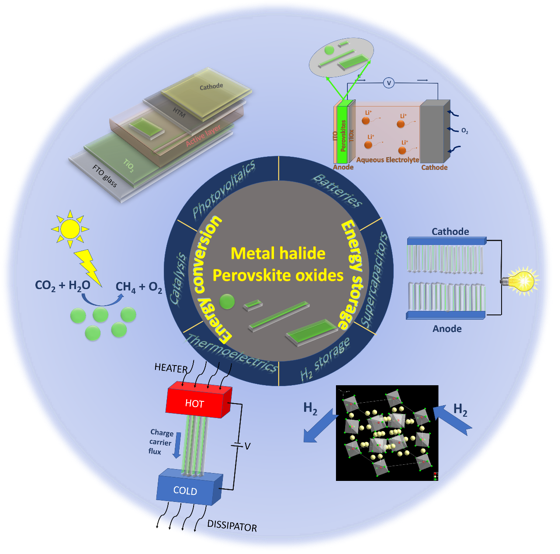
The research of our group is mainly focus on the development of all-inorganic metal halide perovskites. These semiconducting nanocrystals exhibit a completely different behavior from their bulk materials of the same stoichiometry due to quantum confinement effects. Optical/electronic properties can be affected in an unexpected way from the size/shape particle modifications. Their fascinating properties together with their colloidal form make these materials ideal candidates for application in energy-related applications.
Wet chemistry approaches have been used for the synthesis of perovskite nanostructures in centrosymmetric or non-centrosymmetric morphologies (spherical particles, nanoplatelets, nanosheets or more complex structures). These approaches have been carefully selected because they can allow developing finely size-, shape-, and composition- tailored nanocrystals by careful regulation of thermodynamically/kinetically driven growth processes in the liquid phase.
The perovskite nanocrystals synthesized with wet chemistry methods are well crystalline and dispersed in organic solvents as they covered with organic ligands. They exhibit very high quantum yields, narrow line width and high stability. Their emission could cover the whole visible range by modifying their composition, morphology and size.
Metal halide perovskite nanostructures covered by organic molecules or free of ligands have been grown in colloidal solutions and then deposited on substrate or grown directly on it. Their structural features together with their physical properties have been carefully investigated and the impact of the structure, morphology, and composition on energy device performance have been evaluated.

A facile and rapid photo-induced process to conjugate graphene-based materials with metal-halide perovskite nanocrystals has been explored. A small number of laser pulses is sufficient to decorate the 2-dimensional (2D) flakes with metal-halide nanocrystals without affecting their primary morphology. At the same time, the density of anchored nanocrystals can be finely tuned by the number of irradiation pulses. This facile and rapid room temperature method provides unique opportunities for the design and development of hybrid perovskite-2D materials nanoconjugates; exhibiting synergetic functionality by combining nanocrystals of different morphologies and chemical phases with various 2D materials.

The unique features of these materials together with the unique tunability in composition, shape and functionalities make these nanocrystals, uniquely suited for varied applications. The potential utilization of these nanocrystals in energy storage as anode materials in Li-air batteries or in gas sensing application as active materials to detect ozone or hydrogen.
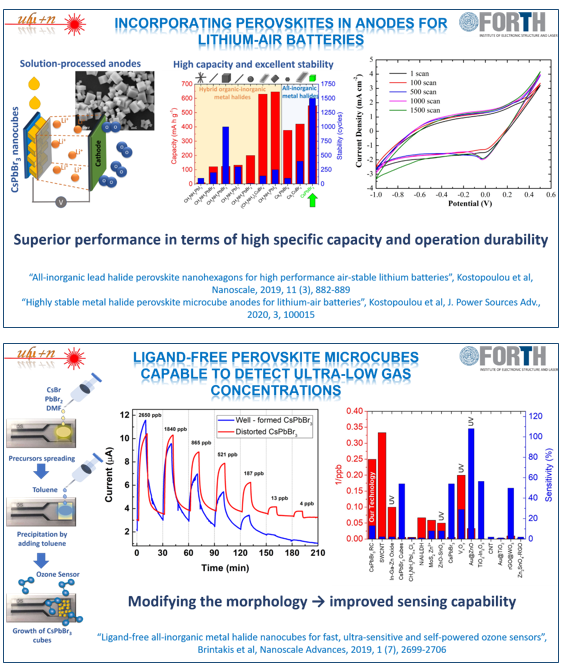
PUBLICATIONS
[1] Investigation of Si-Coated Multiwalled Carbon Nanotubes as Potential Electrodes for Multivalent Metal-Ion Electrochemical Energy Storage Systems, S. Daskalakis, A. Kostopoulou, K. Brintakis, E. Stratakis, V. Prasad Prasadam, K. Menguelti, N. Bahlawane, D. Vernardou, The Journal of Physical Chemistry C 2023, 127 (27), 13364-13379, https://doi.org/10.1021/acs.jpcc.3c02871
[2] Two-dimensional metal halide perovskites and their heterostructures: from synthesis to applications, A. Kostopoulou, I. Konidakis, E. Stratakis, Nanophotonics 2023, 12 (9), 1643-1710, https://doi.org/10.1515/nanoph-2022-0797
[3] Highly sensitive ozone and hydrogen sensors based on perovskite microcrystals directly grown on electrodes, A. Argyrou, K. Brintakis, A. Kostopoulou, E. Gagaoudakis, I. Demeridou, V. Binas, G. Kiriakidis, E. Stratakis, Journal of Materiomics 2022, 8 (2), 446-453, https://doi.org/10.1016/j.jmat.2021.07.002
[4] Laser-induced morphological and structural changes of cesium lead bromide nanocrystals, A. Kostopoulou, K. Brintakis, M. Sygletou, K. Savva, N. Livakas, M. A. Pantelaiou, Z. Dang, A. Lappas, L. Manna, E. Stratakis, Nanomaterials 2022, 12 (4), 703, https://doi.org/10.3390/nano12040703
[5] Highly stable metal halide perovskite microcube anodes for lithium-air batteries, A. Kostopoulou, D. Vernardou, D. Makri, K. Brintakis, K. Savva, E. Stratakis, Journal of Power Sources Advances 2020, 3, 100015, https://doi.org/10.1016/j.powera.2020.100015
[6] Laser-Assisted Fabrication for Metal Halide Perovskite-2D Nanoconjugates: Control on the Nanocrystal Density and Morphology, A. Kostopoulou, K. Brintakis, E. Serpetzoglou, E. Stratakis, , Nanomaterials 2020, 10 (4), 747, https://doi.org/10.3390/nano10040747
[7] Highly luminescent and ultrastable cesium lead bromide perovskite patterns generated in phosphate glass matrices, I. Konidakis, K. Brintakis, A. Kostopoulou, I. Demeridou, P. Kavatzikidou, E. Stratakis, Nanoscale, 2020,12, 13697-13707, https://doi.org/10.1039/D0NR03254A
[8] Perovskite nanocrystals for energy conversion and storage, A. Kostopoulou, K. Brintakis, NK. Nasikas, E. Stratakis, Nanophotonics 2019, 8, 1607-1640, https://doi.org/10.1515/nanoph-2019-0119
[9] The role of ligands in the chemical synthesis and applications of inorganic nanoparticles, A. Heuer-Jungemann, N. Feliu, I. Bakaimi, M. Hamaly, A. Alkilany, I. Chakraborty, A. Masood, M. F. Casula, A. Kostopoulou, E. Oh, K. Susumu, M. H. Stewart, I. L. Medintz, E. Stratakis, W. J. Parak, A. G. Kanaras, Chemical Reviews 2019, 119, 4819-4880 (Front Cover), https://doi.org/10.1021/acs.chemrev.8b00733
[10] Ligand-free all-inorganic metal halide nanocubes for fast, ultra-sensitive and self-powered ozone sensors, K. Brintakis, E. Gagaoudakis, A. Kostopoulou, V. Faka, K. Argyrou, V. Binas, G. Kiriakidis, E. Stratakis, Nanoscale Adv. 2019, 1, 2699-2706, https://doi.org/10.1039/C9NA00219G
[11] All-inorganic lead halide perovskite nanohexagons for high performance air-stable lithium batteries, A. Kostopoulou, D. Vernardou, K. Savva, E. Stratakis, Nanoscale 2019, 11, 882-889, https://doi.org/10.1039/C8NR10009H
[12] Unveiling the Structure of MoSx Nanocrystals Produced upon Laser Fragmentation of MoS2 Platelets, K. Alexaki, A. Kostopoulou, M. Sygletou, G. Kenanakis, E. Stratakis, ACS Omega 2018, 3 (12), 16728-16734, https://doi.org/10.1021/acsomega.8b01390
[13] Perovskite nanostructures for photovoltaic and energy storage devices, A. Kostopoulou, E. Kymakis, E. Stratakis, J. Mater. Chem. A, 2018, 6, 9765-9798, https://doi.org/10.1039/C8TA01964A
[14] Anion Exchange in Inorganic Perovskite Nanocrystal Polymer Composites, M. Sygletou, M.E. Kyrazi, A.G. Kanaras, E. Stratakis, Chemical Science 2018, 9, 8121-8126, https://doi.org/10.1039/C8SC02830C
[15] Low-temperature Benchtop-synthesis of All-inorganic Perovskite Nanowires, A. Kostopoulou, M. Sygletou, K. Brintakis, A. Lappas, E. Stratakis, Nanoscale, 2017, 9, 18202-18207, https://doi.org/10.1039/C7NR06404G
Project Members:
Dr Emmanuel Stratakis (PI, Research Director)
Dr Athanasia Kostopoulou (Co-PI and subgroup leader, Research Associate)
Dr Konstantinos Brintakis (Co-PI, Research Associate)
Dr Konstantina Alexaki (Research Associate)
Mrs Aikaterini Argyrou (PhD Candidate)
Mrs Maria Syskaki (Master Student)
Mr Nikos Kavousanos (Master Student in collaboration with HMU)
Alumni
Dr Kyriaki Savva
Dr Maria Sygletou
Mrs Michaila-Akathi Pantelaiou
Mr Nikolaos Livakas
Mrs Serpil Kiokekli
Mrs Markella Splinaki
Mrs Maria Peraki
Collaborators
Prof Liberato Manna (Istituto Italiano Di Tecnologia)
Dr Joanathan Beauchamp (IVV Fraunhofer)
Dr. Dimitra Vernardou (Hellenic Mediterranean University, HMU)
Dr. George Kioseoglou (University of Crete)
Dr. Emmanuel Gagaoudakis (IESL-FORTH)
Dr. Vasileios Binas (IESL-FORTH)
Prof George Kyriakidis (IESL-FORTH)
Dr. Konstantinos Petridis (HMU)
Dr. Alexandros Lappas (IESL-FORTH)
Dr. Mirko Prato (Istituto Italiano Di Tecnologia)
Dr. Giorgio Divitini (Istituto Italiano Di Tecnologia)
Dr Iurii Ivanov (Istituto Italiano Di Tecnologia)
Prof Antonios Kanaras (University of Southampton)

Description
The use of additive manufacturing especially fused filament fabrication (FFF) 3D printers have been launched in the last decade as it is easy to use and accessible to everyone. It is a common way to alter the surface of the 3D printed scaffold after is printed with subtractive manufacturing techniques. The most well-known subtractive techniques they used are either with laser (ablation, cutting) or with chemical etching. Although, with laser ablation technique, you could abstract more specific, small designs and use a variety of materials. Until now, they only alter the surface of the scaffolds and at some of them the second layer with changing of the focus. In this way, you could alter the surface of the scaffold with designs more complex and smaller than the resolution of the printer or you could make it more porous [1,2,3,4,5,6]. Moreover, there are many filaments that used for 3D printing but a few of them, mainly polymers used for medical applications. PLA is the most used polymer, PCL, PLGA, PEEK, PET, PLLA and for natural polymer chitosan. In this research project we combined the subtractive and the additive manufacturing to construct 4D scaffolds for tissue engineering.
Specifically, we combined the Ytterbium Picosecond Fiber Laser, wavelength 1060 nm, a galvo scanner and Fused Filament Fabrication (FFF) 3D printer . The use of Galvo is to scan surfaces faster and to have less vibrations (figure 1-3). Moreover, there are many techniques to make 3D scaffolds, but the FFF is a cheap technique, with resolution approximately 100 μm. With combination of laser and galvo, the resolution of laser will be approximately 35μm. So, we can construct structures with laser, with smaller resolution than that of the 3D printer. Furthermore, this combination aims to remove material with specific structure at any layer of the 3D printing structure. This result in making 4D scaffolds with higher resolution, roughness and porosity to make easier the proliferation, attachment and the transfer of nutrients for the cells.
To make the whole setup functional we made some custom parts using FFF technology and other machining methods. A second lead screw, with a stepper to drive it, attached in order to handle the weight of the galvo. Some custom-made 3D printed parts were manufactured to mount the optics in the right place and give a controlled movement of galvo in the desired axis. In order to control all the 3D printers and laser parameters a program written in python was what we built. We can make any desired pattern to our samples either using the 3D printer or the laser. This combination covers the demand for complex scaffolding designs and with an increased resolution compared to 3D printers.
The figures 7 shows the first experimental results from SEM where we ablated only the surface of the mesh with lines of width about 50 um and depth about 67 um. We can observe that the ablated lines are recognizable, and at the center of each strap. Although, there is obvious melting on the surface of the mesh. Then we cultured 100K MSCs for 2 days. We can observe that at all scaffolds the cells proliferated and attached well. Also, the MSCs cells exist between the straps of the mesh, the below layer and inside the ablated designs. This was the first experiment and we wanted to make sure that the cells will be attached and proliferate at the natural PLA filament and the results were positive.
The figure 8 depicts a mesh scaffold with dimensions 10x10 with two different gaps of 0.32 and 0.50 mm and 30 ablated layer by layer holes. We can see that he surfaces of the scaffolds are smooth, and the holes are not all the same size, they are approximately 85 um, analogue to the depth of the hole. Then we cultured 50K MSCs cells for 2, 4 and 8 days. At figure 8 we can observe the cells for 8 days, that proliferated and attached well on the surface, inside and on top of the ablated holes. Also, the MSCs cells grown between the straps of the mesh and at the layer below. At last, we can see a detachment of the cells layer, this is due to the sample preparation and fixation of cells to observe them at SEM.
The figure 9 shows the orthogonal scaffold (10x5mm) with 3 different depths of ablated rectangles (0.15, 0.45 and 0.90 mm) and dimensions of 0.5x1 mm. On the surface it has some gaps at the layers where the laser is occurred. This may be fault of the printer because, the designs are small(10x5) and this may have occurred incoherence in the design or under extrude problem at these layers. Moreover, the ablated rectangles are very clean, they do not have excess material at the sides, but they have a significant roughness, also there have not so much melting around the rectangles. The surface of the main orthogonal is smooth but with splashes of material on the surface. In this case, we can observe if the depth plays a role at the proliferation of the cells. We cultured 50K MSCs cells for 2,4 and 8 days, we can see that the depth indeed plays a role at the cells culture. The 0.15 mm depth seems that has more cells than the other depths. This is appeared from the cells that exist, the cracking on the surface which is due to the fixation of cells, the smother surface of the ablated rectangles and the layer of cells around and above the ablated rectangles.
Bibliography
Figure 1. The final set-up that consist of a galvo scanner (SINO), a FFF 3D printer (Ender 3 pro), Ytterbium ΙR picosecond fiber laser (IPG), an optical path and custom-made parts
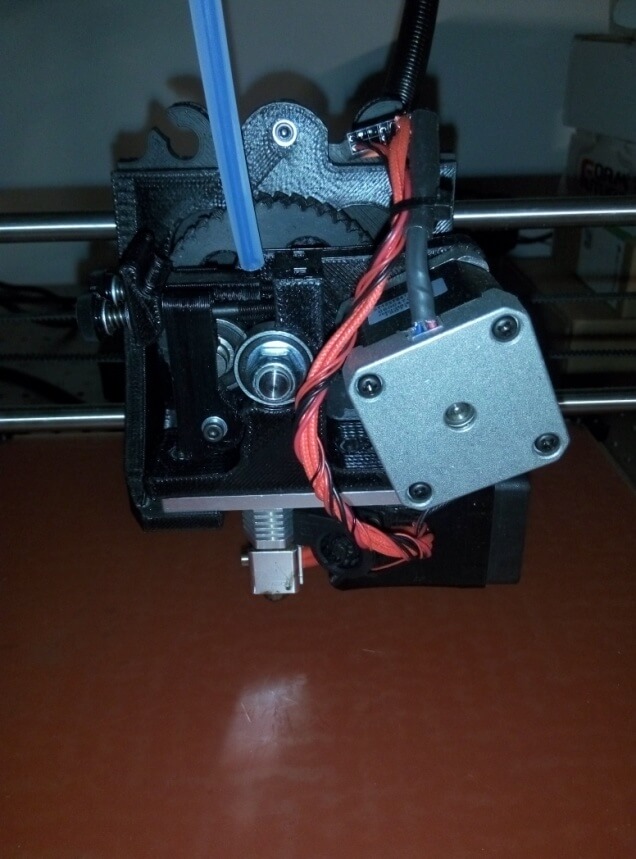 Figure 2. The setup where the custom-made parts help the galvo movement and support.
Figure 2. The setup where the custom-made parts help the galvo movement and support.
Figure 3. Laser’s path to the galvo scanner.
Figure 4. Custom-made program with Python for controlling the galvo scanner, the 3D printer and the combination of both. A) the main window B) control of 3D printer C),D) Insert the laser’s, printer’s or the both designs and we can move, duplicate, down scale and control the at what layers the laser will occur.
Figure 5. The program of the laser, where we can control the pulse duration (0.15,1,2 and 3 ns), the power and the repetition rate.
Figure 7. Mesh with 100μm space and ablated grooves 5ns, 5 KHz and 3.79 Watts (A-D) and with 2 days in 100k MSCs cell culture(E-H).
Figure 8. Mesh with 2 different gaps (0.31 and 0.50mm) and 30 ablated (5ns, 2KHz and 1.91 Watts) holes of diameter 0.70 mm (A,B) and 7 days of 50K MSCs culture (C-F).
Figure 9. Top and tilted view of SEM images for orthogonal with 3 different depth of ablated rectangles (0.15, 0.45 and 0.90mm) and distances 1x0.5 with laser parameters 5ns, 5KHz, 3.92 Watts, 100mm/sec and mark time =16 (A,B) and the second picture with 50K concertation of MSCs cells for 8 days of culture.
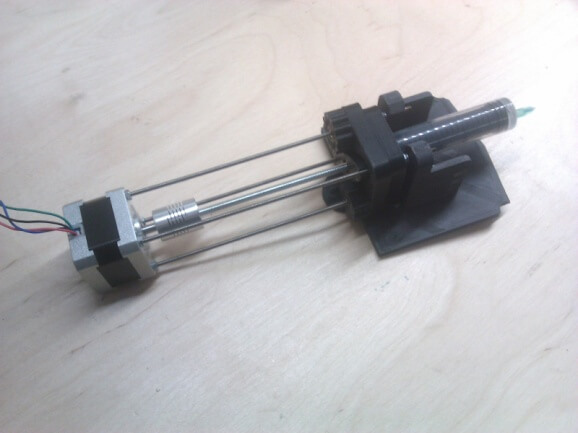

Figure 10: Head used for printing of natural polymers.
Project Members
Mr. Andreas Lemonis
Ms. Lefki Chaniotaki
Mr. Christos Ntoulias
Dr. Eleftheria Babaliari
Dr. Evi Kavatzikidou
Dr. Emmanuel Stratakis
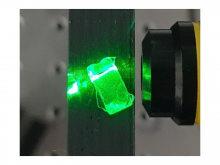
Objective: This research topic aims at the development of advanced composite glasses for state-of-the-art optoelectronic applications by means of simplified novel fabrication synthesis procedures.
Abstract: Over the years, the importance of inorganic oxide glasses in various fields of optoelectronics, photonics and solid state electrochemical technological applications has been demonstrated. A continuous scientific challenge lies in maximizing the functionality of novel glassy materials upon introducing new features, and thus expanding their potential towards next-generation applications and devices, while simplifying their fabrication routes. Along these lines, this research activity focuses on the development of advanced composite glasses by means of two approaches. First, Dr. I. Konidakis has demonstrated in the ULMNP Laboratory a novel, low-temperature, post-melting encapsulation (PME) synthesis protocol for the incorporation of perovskite nanocrystals (PNCs), 2D materials, and metallic nanoparticles (NPs) within inorganic oxide transparent glasses. The developed PME protocol expands beyond the current state-of-the-art in terms of allowing the controlled and confined positioning of the functional materials within the glass. Such aspect is not possible when conventional melting procedures are followed. Second, we take advantage of ultrafast pulsed and continuous wave (cw) laser processing techniques for the introduction of advanced photonic features within the bulk or on the surface of the developed composite glasses.
Perovskite Glasses (PV-Glasses): In the case of perovskite glasses, we have demonstrated the formation of highly luminescent and ultrastable perovskite patterns within phosphate glasses, upon following the simple low-temperature PME fabrication procedure and cw laser processing. The embedded micro-patterns exhibit remarkable photoluminescence stability while their periodicity can be varied according to the photonic application (Figure 1).
Figure 1: Schematic representation of the controlled incorporation of perovskite nanocrystals (PNCs) within inorganic oxide glass by means of low-temperature, post- melting encapsulation (PME). The photoluminescence stability of the composite glass and the formation of a typical perovskite micro-pattern embedded within glass are also shown.
2D materials Glasses (2D-Glasses): Based on the same PME synthesis approach, we have demonstrated the incorporation of 2D materials within phosphate glasses. This allows significant tailoring of the photoluminescence properties of the composite 2D-Glasses. Namely, robust B-exciton emission at room temperature in few layers of MoS2:Ag nanoheterojunctions was induced upon encapsulating MoS2 layers inside silver metaphosphate glass (Figure 2). The obtained remarkable B-exciton emission is attributed to enhanced exciton-plasmon coupling that takes place in silver nanoparticles-MoS2 nanoheterojunctions. Such findings provide a promising way towards tailoring the emission properties targeting application devices working with B-exciton emissions.
Figure 2: Schematic representations of the incorporated MoS2 flakes inside the transparent AgPO3 glass (left), and the mechanism illustrating the exciton-plasmon coupling (center). Room temperature PL emission of pristine AgPO3 glass, MoS2 on Si substrate, and incorporated MoS2 within AgPO3 glass (right).
Photochromic glasses: Photochromic glasses offer solutions in various types of temperature regulation, irradiation protection, and energy saving challenges that have become of particular importance. In this activity we employ the post-glass melting encapsulation protocol for the development of advanced composite photochromic glasses upon incorporating AgCl crystals within transparent phosphate glasses. The developed glasses exhibit remarkable photochromic features with brief response times that exceed the current state-of-the-art, while ongoing work focuses on maximizing the percentage of photochromic switching at various wavelengths (Figure 3).
Figure 3: UV irradiation of the AgCl-AgPO3 composite glass (left). Optical absorbance before and after various periods following UV irradiation (center), and photochromic switching response versus time (right).
Optical waveguides: In the frame of this activity we have developed a new concept of how to prepare advanced glass waveguides that allow transmission of light in different directions simultaneously, without the need for chemical etching procedures and ultrafast laser processing. The latter methods are the current state-of-the-art (SOA) benchmark. Based on this, it is believed that the PME innovative route will be a game changer in the field of waveguides and photonic circuits development both in lab prototypes and industrial production for two main reasons. First, it simplifies and makes safer the fabrication process without producing liquid toxic wastes, while on the other hand reducing drastically the production cost since the necessity of employing expensive ultrafast laser equipment vanishes. In brief, our novel method relies on the employment of the simple, fast, low-temperature, PME of glass microwires (MWs) within inorganic oxide glasses. The composition of the employed glasses is chosen so that the MWs refractive index is higher than that of the base glass, and thus, forcing the light to travel within the embedded MWs. More importantly, the incorporation of the glass MWs is done with a controlled manner, and allows the creation of distinct pathways within the same waveguide. In such a way, the transmission of light of different colors and in multiple directions is possible within the same waveguide device. Overall, we believe that the proposed method poses important technological advancements and opens the doors for the industrial scale production of glass waveguides and composites glasses for various photonic circuits, optoelectronic, and smart sign applications.
Figure 4: Indicative optical waveguides upon the incorporation of glass microwires (MWs) within glasses by means of the innovative post-melting encapsulation (PME).
The Glas-A-Fuels vision: The novel PME approach of Dr. I. Konidakis resulted in the successful evaluation of the HORIZON-EIC-2023-PATHFINDER-01-01 proposal, Glas-A-Fuels. “Single-Atom Photocatalysts Enhanced by a Self-Powered Photonic Glass Reactor to Produce Advance Biofuels”.
Active projects: Glas-A-Fuels, TheSmartMat.
Contact persons: Dr. Ioannis Konidakis, Dr. Emmanuel Stratakis.
Project members: Dr. Ioannis Konidakis, Mr. Harris Goniotakis, Dr. Emmanuel Stratakis.
Projects members Alumni: Dr. Abdus S. Sarkar, Dr. Efthymis Serpetzoglou, Dr. Konstantinos Tsimvrakidis, Miss Anna Karagiannaki, Mr. Marios Adamidis.
Collaborators: Dr. Ioanna Demeridou, Prof. George Kioseoglou.
Selected publications:
1. “Post-glass melting synthesis and photochromic properties of composite AgCl-AgPO3 glasses”, M. Adamidis, I. Konidakis* and E. Stratakis, J. Materiomics 9, 455 (2023).
2. “Laser-induced erasable and re-writable waveguides within silver phosphate glasses”, K. Tsimvrakidis, I. Konidakis and E. Stratakis, Materials 15, 2983 (2022).
3. “Advanced composite glasses with metallic, perovskite, and two-dimensional nanocrystals for optoelectronic and photonic applications”, I. Konidakis, A. Karagiannaki and E. Stratakis, Nanoscale 14, 2966 (2022).
4. “Probing the effect of a glass network on the synthesis and luminescence properties of composite perovskite glasses”. A. Karagiannaki, I. Konidakis, G. Kourmoulakis, I. Demeridou, J. Dzibelova, A. Bakandritsos and E. Stratakis, Opt. Mater. Express 12, 823 (2022).
5. “Robust B-exciton emission at room temperature in few-layers of MoS2:Ag nanoheterojunctions embedded into a glass matrix”, A.S. Salam, I. Konidakis, I. Demeridou, E. Serpetzoglou, G. Kioseoglou and E. Stratakis, Sci. Rep. 10, 15697 (2020).
6. “Highly luminescent and ultrastable cesium lead bromide perovskite patterns generated in phosphate glass matrices”, I. Konidakis, K. Brintakis, A. Kostopoulou, I. Demeridou, P. Kavatzikidou and E. Stratakis, Nanoscale 12, 13697 (2020).
7. “Effect of composition and temperature on the second harmonic generation in silver phosphate glasses”, I. Konidakis, S. Psilodimitrakopoulos, K. Kosma, A. Lemonis and E. Stratakis, Opt. Mater. 75, 796 (2018).
8. “Erasable and rewritable laser-induced gratings on silver phosphate glass”, I. Konidakis, E. Skoulas, A. Papadopoulos, E. Serpetzoglou, E. Margariti and E. Stratakis, Appl. Phys. A 124, 839 (2018).
9.“Change of conduction mechanism in polymer/single wall carbon nanotube composites upon introduction of ionic liquids and their investigation by transient absorption spectroscopy: implication for thermoelectric applications”, B. Krause, I. Konidakis, E. Stratakis and P. Pötschke, ACS Appl. Nano Mater. 6, 13027 (2023).




